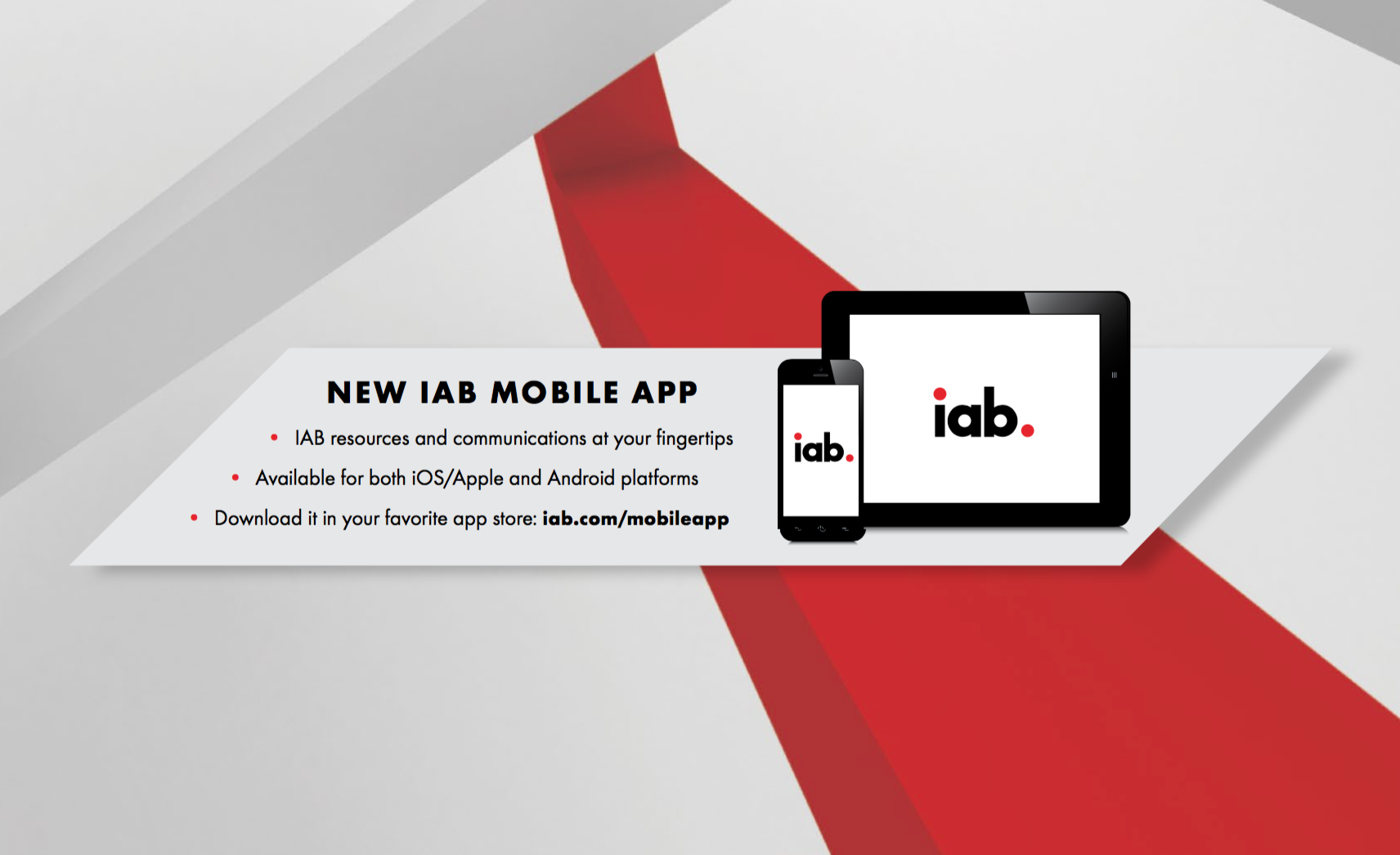Building 21st Century Brands: The Race to the New Economy

In the digital media and marketing industries, we breathed the paradox every day. 2017 was both our most productive year since IAB’s founding, and perhaps the most disruptive. Spending on digital advertising reached an all-time high of $40.1 billion in the first six months of 2017, an increase of 22 percent over 2016 (IAB Internet Advertising Revenue Report, December 2017). But it was also the year that Russian bots, “fake news,” and the other maladies IAB has been warning about (and correcting for a decade) moved from the trade magazines to the front pages and their digital equivalents.
It’s easy to get distracted by the headlines and the relentless assault of novelty, and thus lose sight of the bigger transformations roiling underneath. In the consumer economy, we are in the midst of an epochal shift from a century-old “indirect brand economy” to a “direct brand economy.” Brands characterized by their direct connections to consumers and the insightful manipulation of their flexible supply chains are disrupting the business models of market-leading brands that in some cases have led their categories for decades. While Casper, Dollar Shave Club, Glossier, Uber, and Warby Parker are well recognized for their successes, tucked away next to them are hundreds of others, in every category, using the same capabilities to shift share growth to their corner, one fraction of a share point at a time. These direct brands—as well as the incumbents that join their club—are the growth engine of the new brand economy.
Adapting to this new landscape is not optional either: Two-thirds of consumers now expect direct brand connectivity.
The world has shifted from an indirect brand economy to a direct brand economy.
A new world? Indeed. Clear sailing? No way. Consider the disruptions that could disrupt the disruptors:
- Ill-considered, badly written, seat-of-the-pants government regulations in the U.S. and Europe threaten to gut the new direct brand industry.
- A flawed, porous digital media supply chain continues to endanger both brand safety and consumer safety, prompting politicians as well as normal human beings toward their cynicism about digital channels.
- Having struggled to keep up with the pace of media disruption and its impact on their advertising, brands are now straining to keep up with the ways the same digital technologies are disrupting the production, distribution, and fulfillment of their consumer goods and services.
To help brands, publishers, agencies, platforms, and technology providers better understand the emerging direct brand economy, IAB introduced several new offerings in 2017 to make it easier for our members and stakeholders to navigate their way to the new world.
In the fall, IAB hosted the IAB Content Studio Showcase, a first-of-its-kind marketplace for publishers’ content studios, to showcase how these dynamic creative powerhouses apply their storytelling expertise to build marketers’ brands. Similarly, the 2017 IAB Leadership Dialogues were a first-ever series of discussions with transformative leaders in business, politics, economics, and technology to gain insights from and debate critical industry, political, and economic issues with each other.
A cross-screen economy requires new standards and guidelines to grow the marketplace, and IAB and the IAB Tech Lab introduced the completely revamped IAB Standard Ad Unit Portfolio, featuring dynamic ads that allow for flexible creative on a multitude of screen sizes and resolution capabilities and that puts user experience front and center. Another major accelerator for growth is a trustworthy supply chain. A major initiative for the Tech Lab in this area was the introduction of the Authorized Digital Sellers program, ads.txt, which has fast gained attention as an essential tool in fighting ad fraud.
From cross-platform measurement to attribution modeling, the IAB Mobile Marketing Center of Excellence, in conjunction with IAB Tech Lab, is focused on developing guidelines and creating digital and cross-media audience measurement metrics that will allow the industry to plan, buy, and sell advertising across all platforms and media seamlessly. IAB has also made great strides in convening the industry’s top video executives and advertising companies to define the agenda for the future of video at the invitation-only Video Leadership Summit, under direction from the IAB Digital Video Center of Excellence.
Data is now at the center of the direct brand economy, and to drive the data agenda for the digital media, marketing, and advertising industry, this year the IAB Data Center of Excellence and the Data and Marketing Association (DMA) released the first-ever market sizing benchmarks for data-related investment, showing that U.S. companies will have spent more than $10 billion on third-party audience data in 2017 for advertising and marketing efforts.
IAB members have asked for more training programs for growing the talent pool and by the end of 2017 more than 14,800 digital media professionals have advanced through the IAB Certification Programs and Professional Development initiatives.
An emerging economy and fast-changing media landscape also requires an active eye on policy, and IAB continues to be a strong force for advocacy on behalf of our members at the federal, state, and global level to help educate industry and regulators in support of policy affecting consumer privacy, data security, supply chain safety, advertising taxation, and other major regulatory and legislative issues.
Finally, digital advertising is responsible for over 10 million jobs in the U.S.—but filling those jobs remains a challenge. The IAB Education Foundation is working hard to deliver a diverse talent pool that reflects the audiences we serve by adding qualified diverse talent to the industry’s employment pipeline through its iDiverse initiative.
As we look ahead to 2018 and beyond, IAB is uniquely positioned to help our members succeed in the new direct economy.
I look forward to an ambitious agenda for our members in 2018 as we devote ourselves to helping our member companies and our industry prosper in the direct brand economy.
Sincerely,
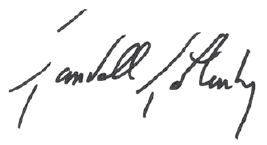
Randall Rothenberg
President and Chief Executive Officer
Interactive Advertising Bureau
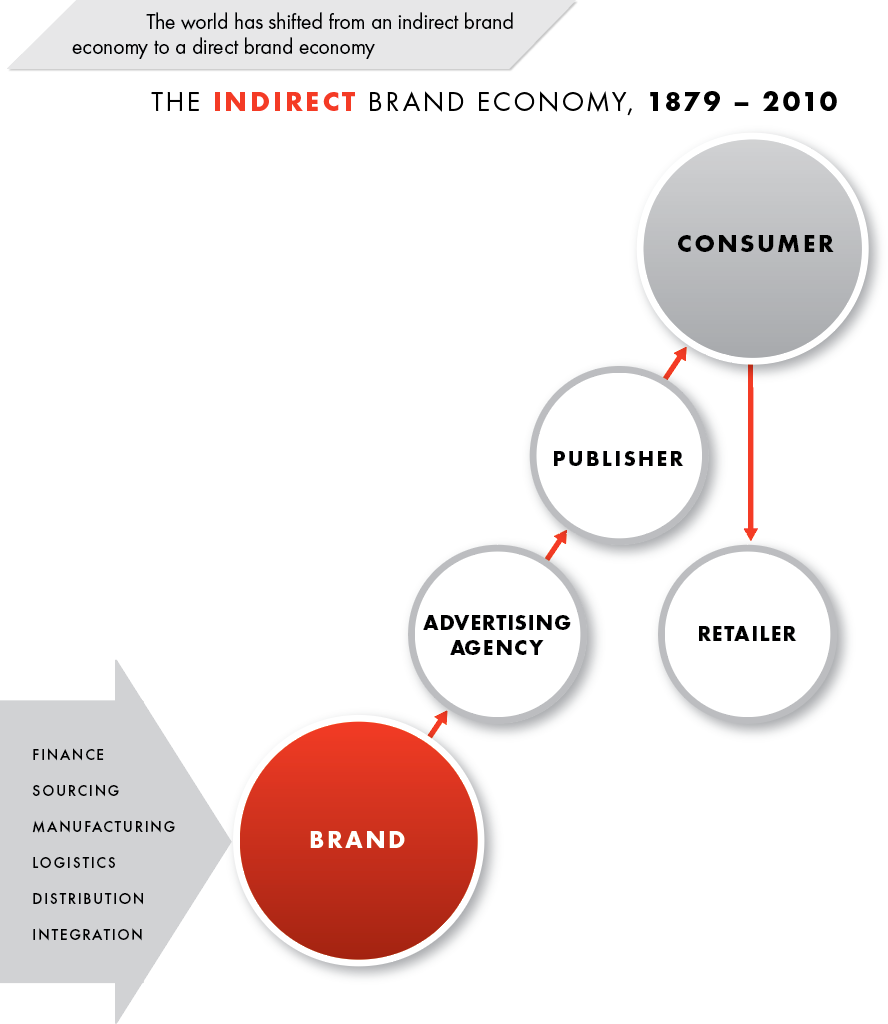
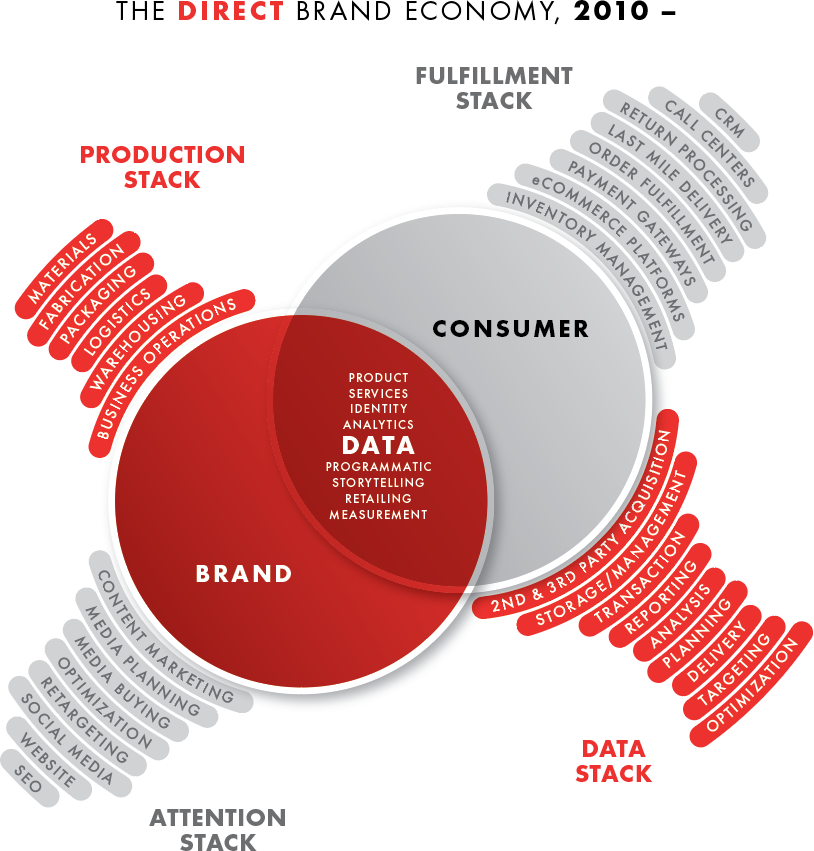
Building Marketplaces
Showcasing World-Class Creativity to Engage and Delight Consumers
Digital advertising was born of technology, and as a result, it’s been oriented around systems and processes, rather than the aesthetics and ideas that captivate hearts and minds and allow brands to change consumer behavior. Marketers are struggling to keep up with the pace of platform evolution and mobility, and need to learn how to use the newest platforms without breaking their own cost base. But brands are clamoring for creativity in a marketplace of competing and increasingly asynchronous platforms.
As part of our efforts to refocus the interactive industry toward inspiring creative, in 2017 IAB continued to host and build creative marketplaces including the always popular IAB Digital Content NewFronts, the increasingly influential IAB Podcast UpFront, and the brand new IAB Content Studio Showcase: Brand New Ideas.
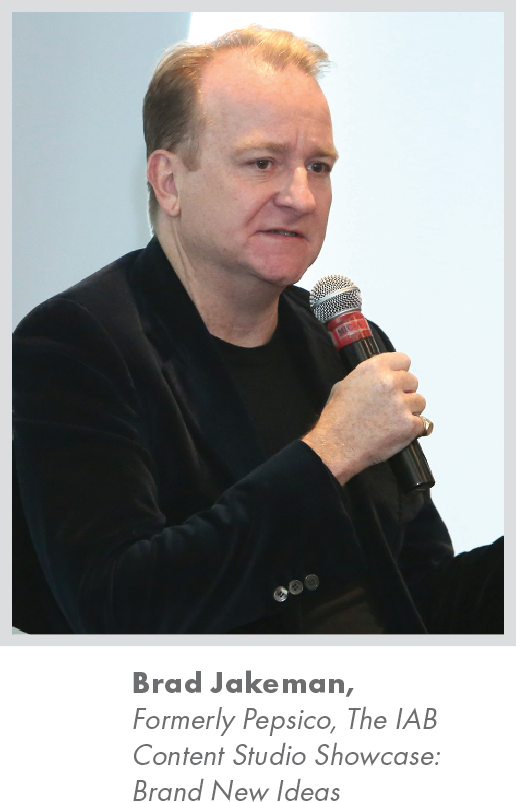 Content Studio Showcase: A Marketplace for Content Creativity
Content Studio Showcase: A Marketplace for Content Creativity
In October, IAB hosted the first-ever IAB Content Studio Showcase: Brand New Ideas, a first-of-its-kind marketplace for publishers’ content studios, to showcase the wealth of ways these dynamic creative powerhouses apply their storytelling expertise to build marketers’ brands. These publisher content studios may be the most significant advance in advertising creativity since the Creative Revolution of the 1960s. Designed for an audience of advertisers, this marketplace featured examples of branded content solutions from some of the biggest names in digital advertising. The invitation-only event, held at The New York Times offices in New York City, was developed in direct response to the dramatic impact content studios are making in the ad industry: allowing brands to directly leverage publishers’ insights and creative talents to tell meaningful stories through native content. The event featured presentations from Partner Studio by AOL, CNN’s Courageous, Condé Nast’s 23 Stories, Disney Co/Op, and Hearst Digital Media’s Custom Content, among others. The marketplace was so well-received and successful in 2017, we expect to continue presenting content showcases around the country in 2018 to help publishers succeed.
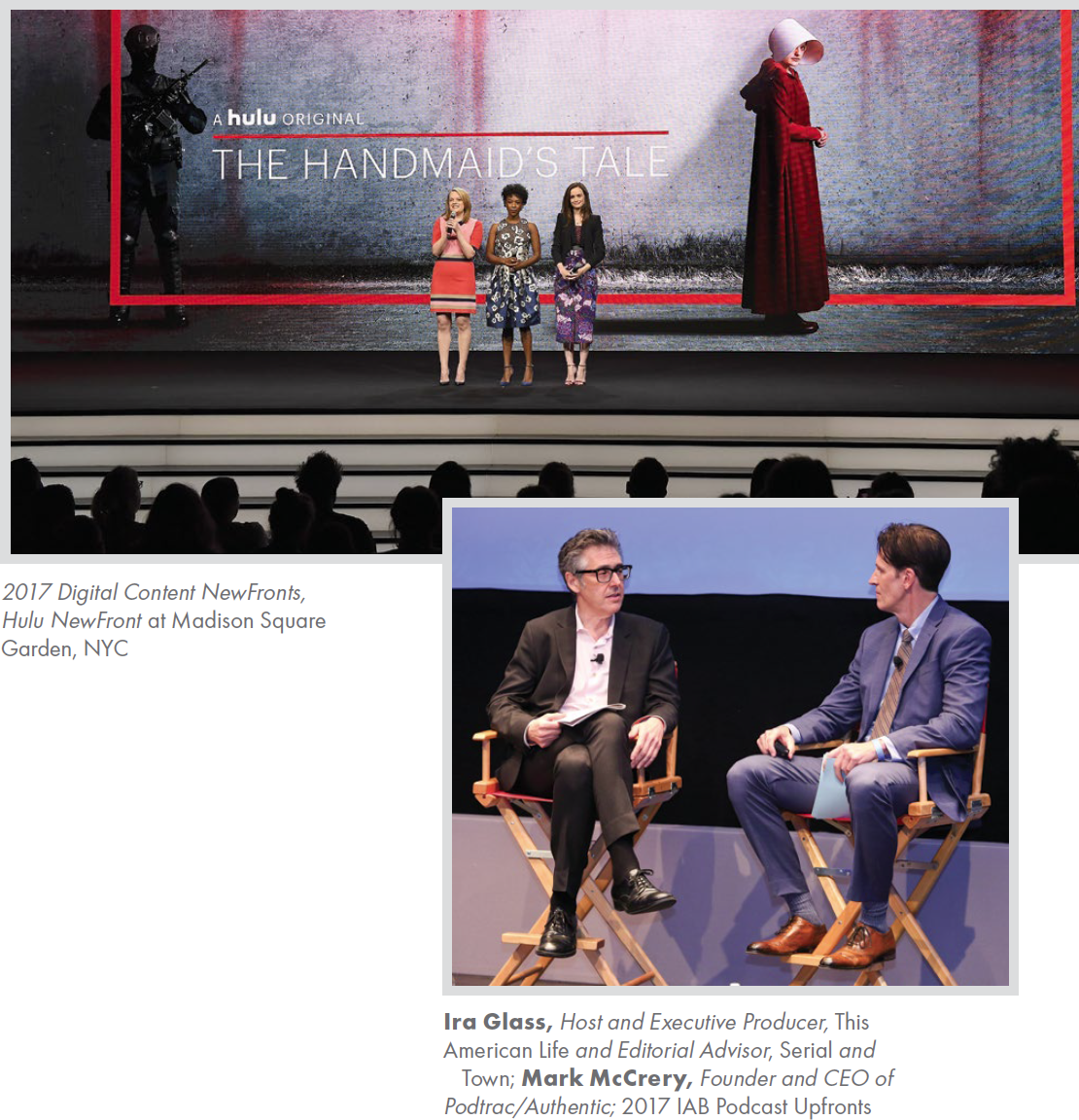
Digital Content NewFronts: A Marketplace for Digital Video Creativity
The IAB Digital Content NewFronts plays a powerful role connecting leading buyers and sellers of digital video content in the largest annual upfront marketplace for digital video. Held in May, the 2017 NewFronts had 33 events attracting approximately 16,000 attendees. Confirming the importance of the event as a catalyst for media buying decisions, nearly nine in 10 advertisers (88 percent) said they increased their original digital video budget as a result of attending the 2016 NewFronts. More than three-quarters (77 percent) agreed that the 2016 NewFronts encouraged them to investigate ways to incorporate new emerging formats such as augmented reality (AR), virtual reality (VR), and 360-degree video advertising into their marketing strategy.
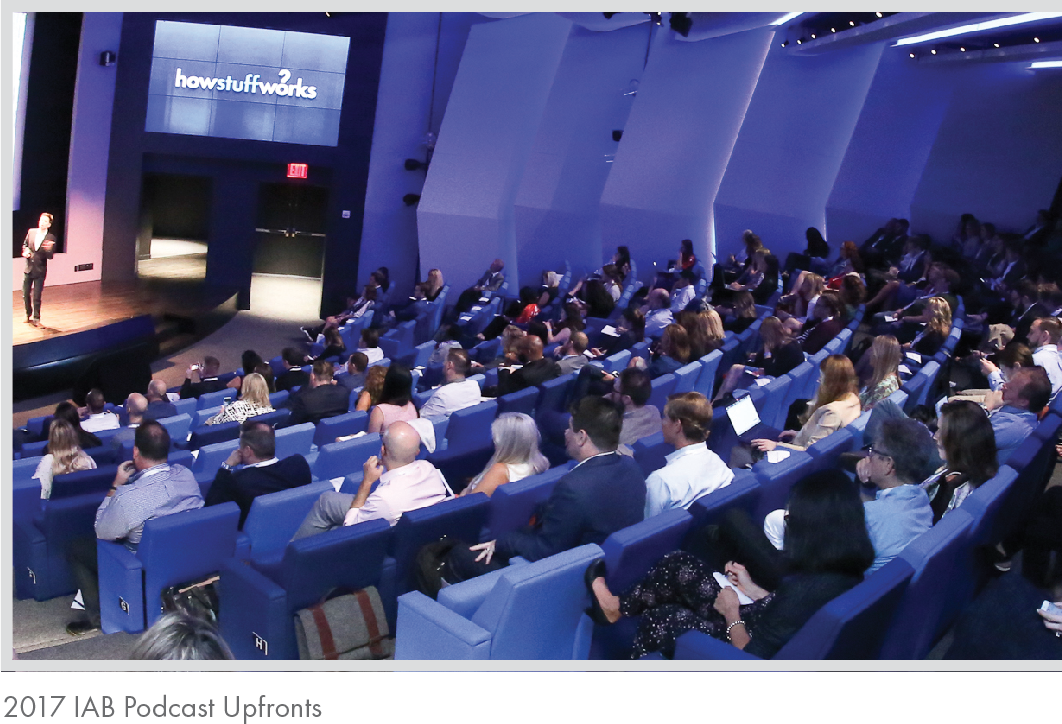 Podcast Upfront: A Marketplace for Audio Creativity
Podcast Upfront: A Marketplace for Audio Creativity
U.S. podcast advertising revenues are forecast to skyrocket to more than $220 million in 2017, an 85 percent increase over 2016, according to the first-ever 2017 IAB Podcast Advertising Revenue Study, driven by connected consumers who rely more and more on mobile devices. But for all their cultural popularity, podcasts remain a bit of a mystery for too many brand marketers, who want to understand how to measure them consistently with other media. To educate marketers and advertisers and raise awareness of podcasting as a valuable platform to reach consumers, in September 2017, IAB produced the third annual Podcast Upfront, a one-day marketplace designed for advertisers and media buyers to preview the latest in innovative podcast programming from some of the biggest names in the digital audio arena. Presenters shared content offerings, audience insights, and opportunities with which advertisers can effectively align their brands and more than 200 marketers attended the event. 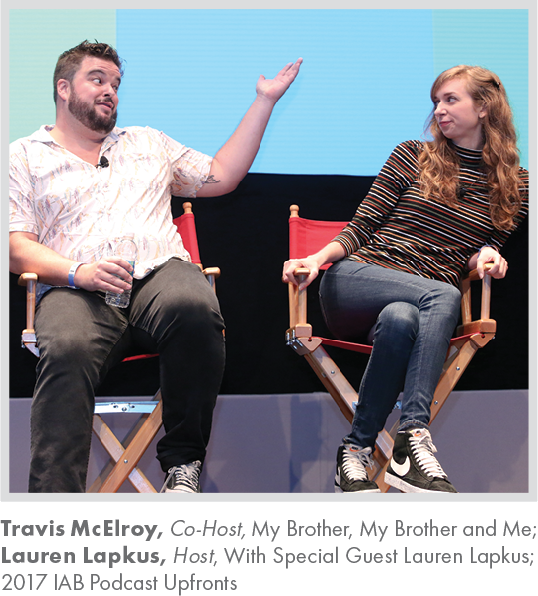
Asserting Global Political Influence
Leading Public Policy & Advocacy Efforts in Washington D.C. and Globally in a Year of Radical Change
In the U.S. and around the world, policymakers are considering legislation and regulations that threaten to impair the digital media industry. Well-meaning government regulation could undermine the ability of smaller and more innovative publishers to compete in the evolving digital economy. In response, IAB advocacy efforts have focused on consumer privacy, data security, supply chain safety, advertising taxation, and other major regulatory and legislative issues to ensure that IAB members’ voices are represented before Congress, as well as at key agencies.
As part of the IAB advocacy and policy efforts in Washington D.C., our public policy team hosted many influential visitors from both the U.S. Congress and European Parliament . These visits were an opportunity to reinforce the value of the digital economy and to demonstrate how legislation affects our industry. IAB also held its fourth-quarter Board meeting in Washington D.C., in order to provide a close-up view of how senior government stakeholders view the industry. Federal Communications Commission (FCC) Chairman Ajit Pai, acting Federal Trade Commission (FTC) Chairman Maureen Ohlhausen, and Senator Ron Wyden, were just a few of the guest speakers from whom IAB Board members got a rare, off-the-record glimpse into the perceptions and future of our industry.
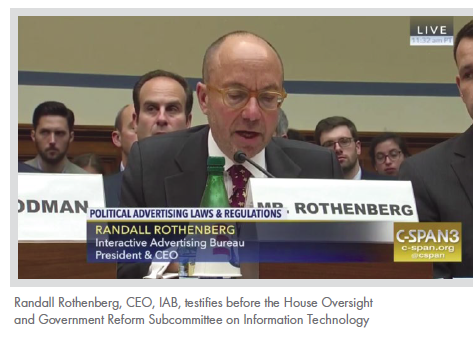 Guidance on Transparency and Disclosure in Digital Political Ads
Guidance on Transparency and Disclosure in Digital Political Ads
On October 24, Randall Rothenberg testified on behalf of the IAB before the House Oversight and Government Reform Committee’s Subcommittee on Information Technology. The hearing, entitled Oversight of Federal Political Advertisement Laws and Regulations, examined the current technological landscape to determine if legislative, regulatory, or other solutions are needed. IAB has always stood for greater transparency and disclosure in the digital advertising supply chain, regardless of whether the ads are political or commercial, because we believe transparency and disclosure are necessary for consumer safety and brand safety.
Economic Value of the Advertising-Supported Internet
Earlier in the year, IAB hosted a congressional luncheon for the launch of the IAB research on the Economic Value of the Advertising-Supported Internet Ecosystem. In attendance at this standing-room only event were key congressional staff, administration officials, and industry stakeholders. The meeting opened with remarks from Congressman Fred Upton, Representative from Michigan, on the importance of the internet ecosystem to the U.S. economy. This research, led by Professor John Deighton at the Harvard Business School, found that the ad-supported internet is responsible for 10.4 million jobs and generated $1.1 trillion for the U.S. economy. The event concluded with a discussion on how to ensure legislation and regulation provide necessary protections for consumers without stifling economic growth and innovation.
Digital Content Showcase with Congress
In October, the IAB Public Policy Office also brought a select group of senior Congressional staff from the House of Representatives to New York for their second ever staff trip second ever staff trip. Starting with the Content Studio Showcase, we were able to demonstrate how digital advertising is evolving. Through our subsequent visits to four IAB member offices—Bloomberg, Hearst, The New York Times, and Pandora—in New York City that day, we were able to reinforce the value of advertising and further the IAB brand in D.C.

Expanding the Global Agenda
In April, IAB hosted an industry roundtable discussion on the recently proposed EU ePrivacy Regulation. Introduced in January, this regulation would replace the current “cookie directive” with new and potentially burdensome requirements on how the digital advertising industry uses cookies and similar technologies for advertising, measurement, and analytics. IAB was joined by a representative from the European Commission, Andrea Glorioso, Counselor for the Digital Economy at the EU Delegation to the United States, and members of the IAB Legal Affairs and Public Policy Councils for this off-the-record discussion on the impact of the proposal and the IAB response.
Guiding the Evolving EU ePrivacy Framework
In September, the IAB Public Policy Office hosted a delegation of Members of the European Parliament for a roundtable discussion in Washington, D.C. The visiting members sit on the Internal Market & Consumer Protection Committee, which has jurisdiction over key issues to our industry, including data protection, digital trade, and standards setting. The event was important to our ongoing efforts to address the harmful legislative proposals that have been introduced in Europe. Participants discussed the challenges they are facing to comply with the evolving privacy framework in Europe, including the General Data Protection Regulation (GDPR) and the proposed EU ePrivacy Regulation.
Accelerating Global Growth
IAB supports our members’ international agendas by leveraging the strength and collaboration of the IAB Global Network, encompassing 44 IAB organizations across 6 continents. The international team aims to further the overall mission of IAB and to serve the interactive ad industry globally by advancing global thought leadership, promoting IAB certification and training programs, and encouraging self-regulation and public policy.
The annual International Breakfast Session at the 2017 IAB Annual Leadership Meeting brought together nearly 70 digital advertising thought leaders from 23 countries spanning from Argentina to Canada, and from Norway to Japan, making it one of the largest gatherings since its start four years ago.
Expanding the IAB Global Network
2017 also kicked off with the Japanese Interactive Advertising Association (JIAA) joining the IAB Global Network as IAB Japan, the forty-fourth IAB licensee. Masahiro Katsuno, Senior Managing Director, JIAA, and JIAA team will work with IAB to drive common goals, promote global standards and guidelines, create better ads, improve consumer experience, and advance the industry’s interests in the Japanese market.
The 2017 IAB Global Summit “Connecting the Global Dots: Marketers, Consumers, and Platforms” welcomed industry leaders from around the world to this invitation-only event that gathered close to a hundred digital leaders from international brands, agencies, publishers, and ad technology companies, together with IAB executives from around the world to disuss and debate salient issues facing our industry globally and the opportunities for future growth.
Convening Thought Leaders
A Driving Force for the Industry’s Leading Priorities
IAB events bring together members, media executives and digital influencers, and attract innovators to the stage to address the most pressing issues facing the digital industry in the U.S. and around the world.
In September, IAB hosted the first-ever 2017 IAB Leadership Dialogues, a series of intimate discussions in which leaders of the marketing, media, and technology sectors interacted with leaders who are reinventing their world.
In 2017, IAB also updated the format of our one day events on programmatic, data, mobile, and video to become more interactive symposiums, adding town halls in the general sessions where the entire audience can engage in discussion and debate around key topics.
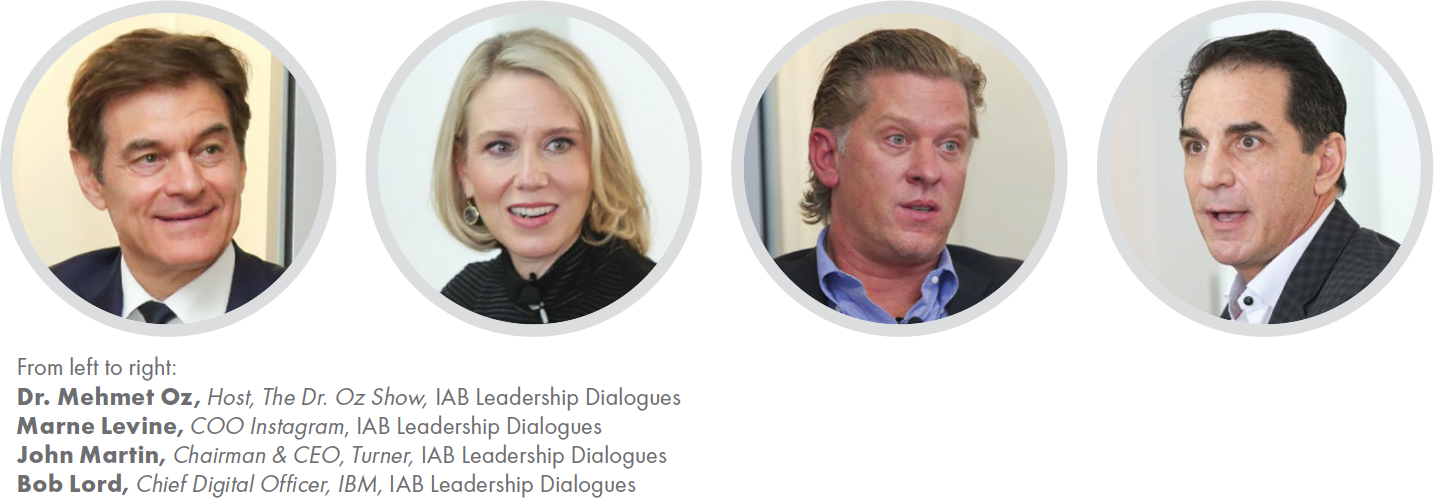
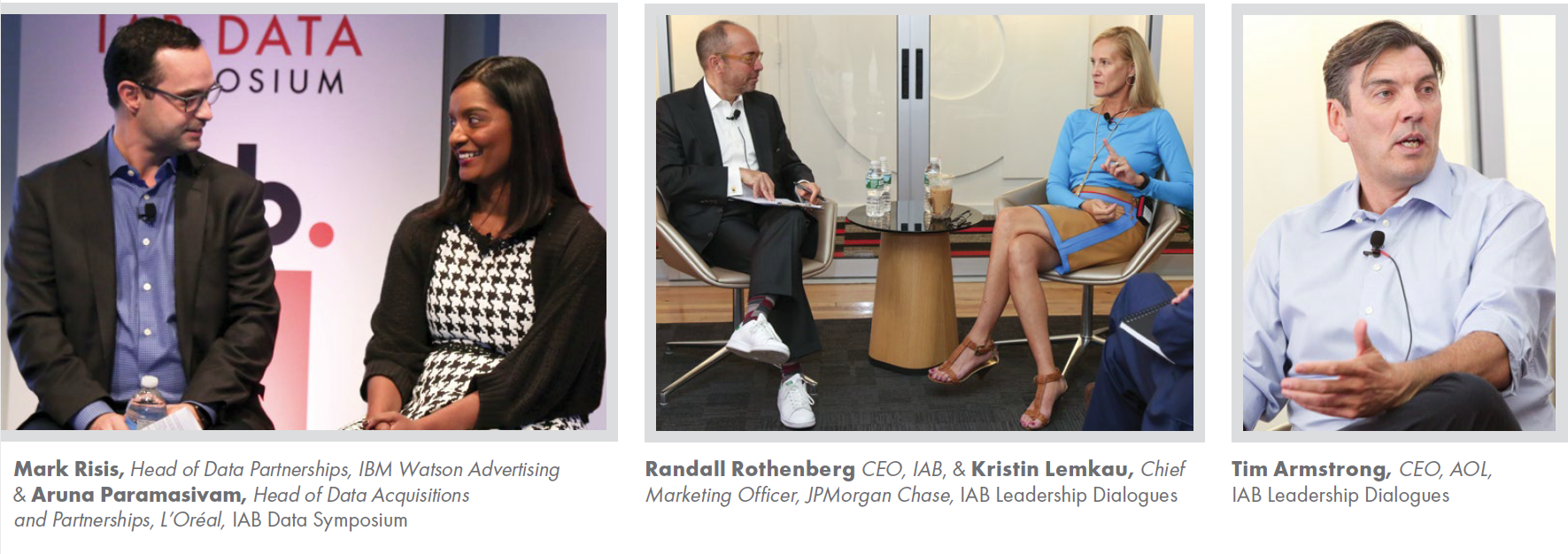
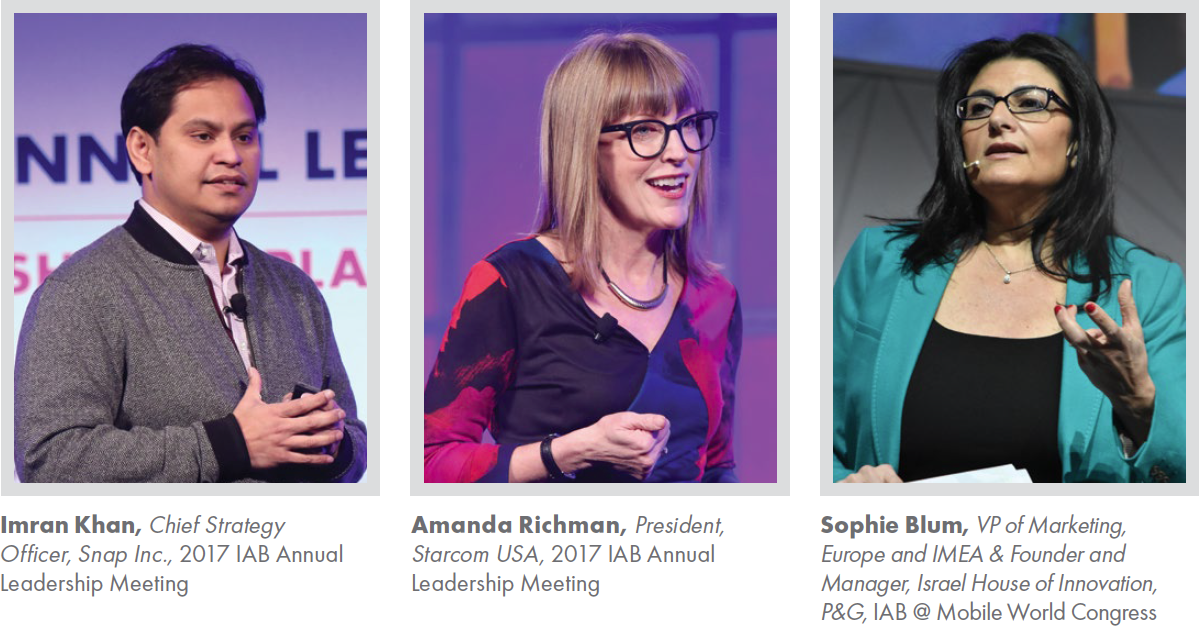
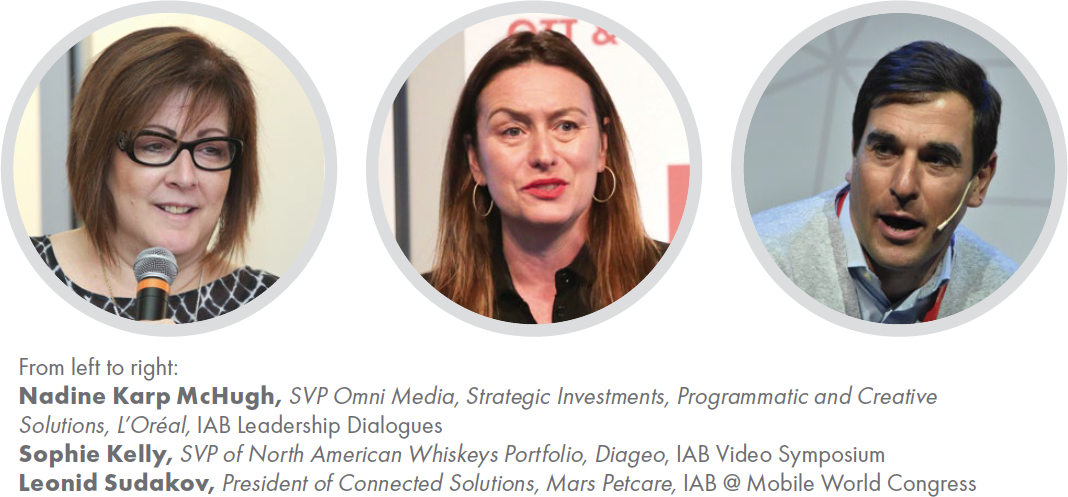
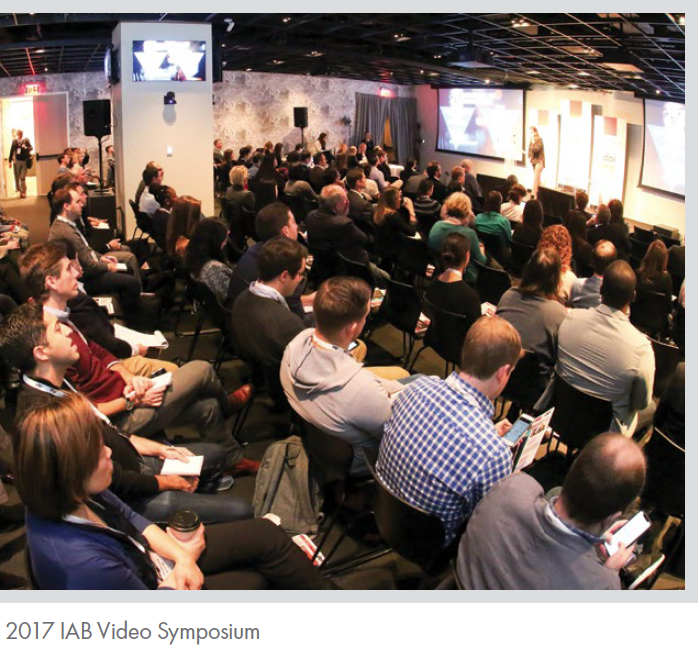
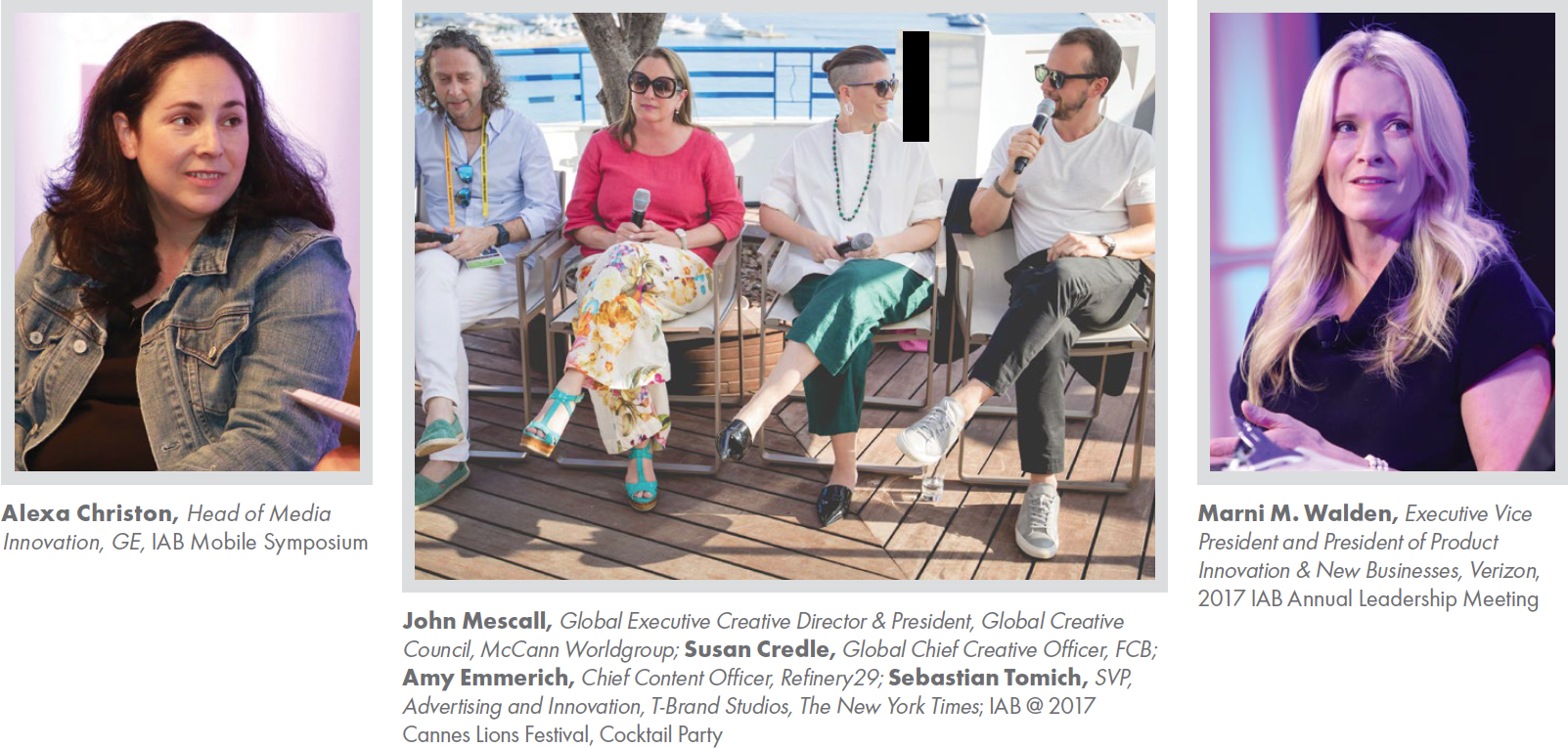
Advancing Brand Safety
Building Trust and Accountability in the Digital Supply Chain
At the IAB Annual Leadership Meeting in January 2017, Marc Pritchard, Chief Brand Officer of Procter & Gamble announced publicly that P&G would only work with companies that have a clean, productive media supply chain by the end of this year. It was a brave and essential move and one we whole-heartedly support. We also believe in the importance of digital standards’ development for the healthy and sustained growth of the supply chain, a core focus of the IAB Technology Laboratory (IAB Tech Lab). In 2017, the IAB Tech Lab has advanced across a number of dimensions.
The IAB Tech Lab develops standards and tools to provide consistent baseline utility to members and industry participants. Some initiatives from the Tech Lab in 2017 included launching the Authorized Digital Sellers program, ads.txt, releasing OpenRTB 3.0 framework and deep engagement with the Trustworthy Accountability Group (TAG) to support their anti-fraud, anti-malware, and inventory quality guidelines, as well as specific initiatives such as TAG ID.
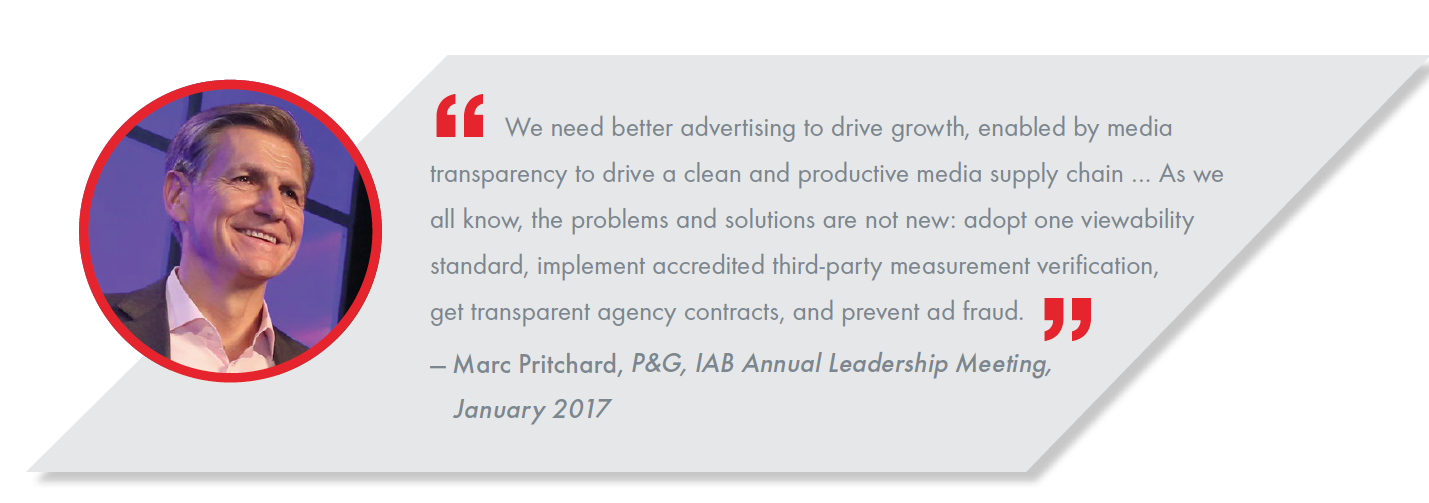
Fighting Fraud by Increasing Transparency and Accountability
Continuing progress to help publishers and advertisers understand the dynamics to fight fraud and improve the digital supply chain, early in 2017 IAB announced that all its member publishers and technology companies will be required to register with TAG—a key digital ad industry’s program to fight fraud and other criminal activity—before June 2018 in order to remain eligible for continued membership in IAB. TAG membership has nearly quadrupled since that announcement, and for the first time, our “cousin” association, the Association of National Advertisers (ANA), which represents brand marketers, has noted in its member research a decline in the incidence of bot fraud affecting its members. Similarly, a study conducted by The 614 Group research confirmed that the use of TAG Certified distribution channels for digital advertising reduced the level of fraud by more than 83 percent from the broader industry average. As IAB continues to lead the industry toward a more transparent and secure supply chain, IAB Tech Lab resources are integral to developing necessary programs and tools to support those efforts.
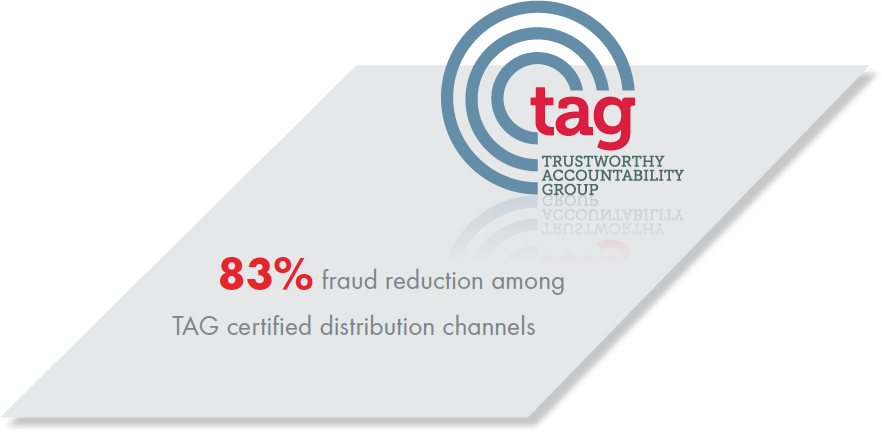 The Authorized Digital Sellers program, ads.txt, has fast gained attention as an important tool in fighting ad fraud. Since its first release in May 2017, the OpenRTB Working Group has incorporated feedback from the industry about use cases that need to be supported via the ads.txt mechanism. The IAB Tech Lab is continuing education and implementation support efforts, especially for mobile apps, and we expect this updated version of the ads.txt spec to accelerate continued adoption in the industry. We encourage adoption of ads.txt by all IAB members.
The Authorized Digital Sellers program, ads.txt, has fast gained attention as an important tool in fighting ad fraud. Since its first release in May 2017, the OpenRTB Working Group has incorporated feedback from the industry about use cases that need to be supported via the ads.txt mechanism. The IAB Tech Lab is continuing education and implementation support efforts, especially for mobile apps, and we expect this updated version of the ads.txt spec to accelerate continued adoption in the industry. We encourage adoption of ads.txt by all IAB members.
Built in part on this initiative, in October, IAB UK announced the establishment of the “IAB Gold Standard,” an effort to reduce ad fraud, improve digital advertising experiences, and increase brand safety in Great Britain. The program requires buy and sell-side implementation of ads.txt and adherence to standards IAB Tech Lab developed with the Coalition for Better Ads (CBA). IAB management is confident that a similar model, in combination with guidance and programs established by the U.S. Media Rating Council (MRC) and TAG, will soon enable new uniform brand safety guidelines worldwide.
Streamlining Standards Compliance
The IAB Tech Lab is also responsible for the development of innovative and scalable technical standards, code libraries to assist in rapid, cost-effective implementation of standards, and test platforms for companies to evaluate the compatibility of their technology solutions with IAB Tech Lab standards, which for almost 20 years have been the foundation for interoperability and profitable growth in the digital advertising supply chain.
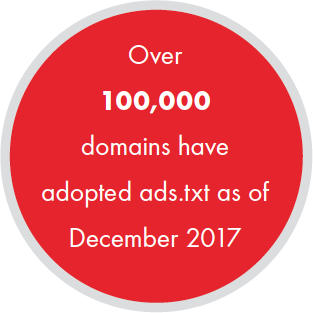 Released in September, the OpenRTB 3.0 Framework draft for public comment includes secure signed bid requests (bid requests (authenticated publisher supply) and an Ad Management API specification that enhances creative management. Both align with a new Advertising Common Object Model (AdCOM) that facilitates consistency across related specifications, and supports demand for authenticated supply and other anti-fraud tools, brand-safe ad experiences, and expanded support for media channels.
Released in September, the OpenRTB 3.0 Framework draft for public comment includes secure signed bid requests (bid requests (authenticated publisher supply) and an Ad Management API specification that enhances creative management. Both align with a new Advertising Common Object Model (AdCOM) that facilitates consistency across related specifications, and supports demand for authenticated supply and other anti-fraud tools, brand-safe ad experiences, and expanded support for media channels.
The Tech Lab was also integral in releasing MRAID—Mobile Rich Media Ad Interface Definitions—an initiative to define a common API (Application Programming Interface) for rich media ads running in mobile apps. MRAID 3.0 includes features to improve consumers’ ad experiences. The new MRAID enables the ad to measure viewability and audibility, detect environment, and obtain location data to present the most relevant experience. MRAID 3.0 also includes guidance on pre-loading ads and understanding readiness to display an ad. The Video Player Ad Interface Definition (VPAID) addendum to MRAID is also now fully included in the MRAID specification.
Additionally, a new Blockchain Working Group has been created by IAB Tech Lab to investigate how to apply blockchain technology to the ad industry to support transparency, billing, reconciliations, and other use cases.
Modernizing the User Experience
Dynamic Solutions That Drive Engagement
Good user experience is at the core of allowing the interactive ecosystem to thrive and our efforts on our members’ behalf are all in support of navigating this new world order.
Dynamic Ads
The IAB Tech Lab saw the need for a standard that would increase the fluidity of ad formats and allow for a more content driven model where an ad simply becomes a real-time rendering of several pieces of content (e.g. an image, a line of copy, an animation, etc.). That need was fulfilled with the release of the IAB Dynamic Content Ad Standard V. 1.0, a structured system of meta data for defining creative components and their asset variations in an ad unit. This standard is designed to help creative developers, ad content management systems, and ad servers build and serve real-time dynamic content in advertisements based on audience data.
In July, IAB released a finalized version of the new IAB Standard Ad Unit Portfolio, featuring ads that allow for creative to adjust to a variety of screen sizes and resolution capabilities. This puts user experience front and center—benefitting both consumers and the brands that want to reach them online. These new ad units have gone through comprehensive testing, with expanded mobile and video capabilities that will propel interactive marketing to new heights. Developed by the IAB Tech Lab, the ad units integrate aspect ratio-based flexible ad sizes, and also incorporate the LEAN Principles of lightweight, encrypted, ad-choice supporting, and non-invasive advertising within all of its mobile, display, and native ad formats. Based on HTML5 technology, it also includes guidelines for new digital content experiences such as augmented reality (AR), virtual reality (VR), social media, mobile video, emoji ad messaging, and 360-degree video ads.

Building Better Ad Standards
IAB also joined forces with the 4A’s and ANA in sending a letter to the Coalition for Better Ads to propose an industry-wide self-regulatory system, including browser makers and delivery tech companies, that would banish the most offensive advertising formats from the internet. IAB has also been participating in the Coalition for Better Ads, a workforce of leading international trade associations and companies involved in online media to improve consumers’ experience with advertising. In March, IAB supported the Coalition’s recommendation that brands, ad agencies, and publishers in North America and Europe voluntarily retire six desktop and 12 mobile advertising formats that fall beneath the threshold of consumer acceptability, and which correlate highly to consumers’ willingness to block ads. As an industry, our common goal should be to make great advertising and content that really engages users with the best possible experience.
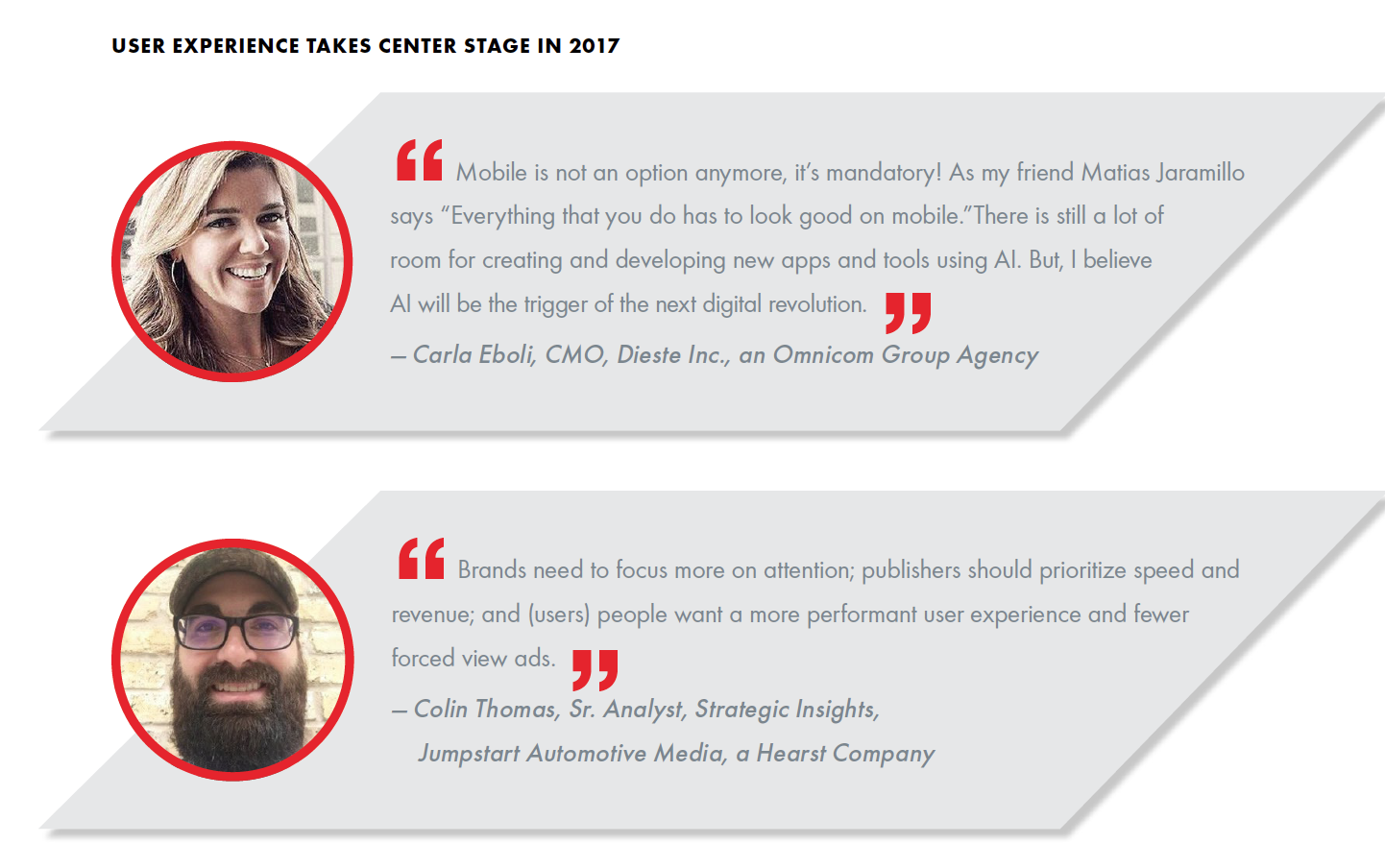
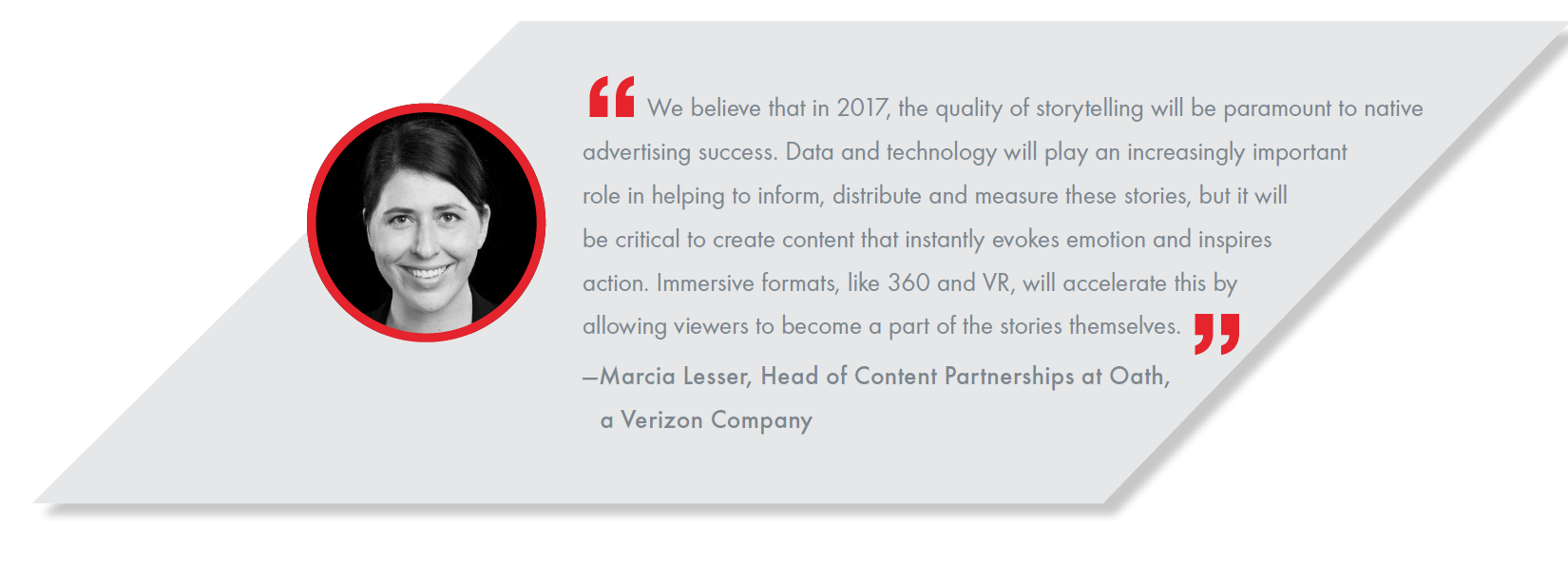
Captivating Mobile Consumers
Improving User Experience in a Direct-to-Consumer Mobile Always World
The consumer march towards mobile has been on, in full speed. In the IAB 2017 Internet Advertising Revenue Report conducted by PwC, U.S. mobile ads account for more than half of digital ad spending. This shift has significant and profound implications for the future of our industry: Mobile ads have surpassed desktop ads. We’ve gone from a world of content and platforms that are mobile-optimized and mobile-first to a new reality where many consumers are mobile only. The IAB Mobile Marketing Center of Excellence is charged with driving the growth of mobile marketing, advertising, and media by creating standards and best practices, and provided research and insights that have helped accelerate the growth of the mobile ecosystem.

Always On – A Global Perspective of Mobile Consumer Experience
After years of uncertainty in the advertising industry about the viability of mobile as a serious medium, mobile advertising fueled more than half of the internet economy in 2016, in no small part because nearly two-thirds of smartphone users worldwide check their device every 30 minutes or more, and nearly half say that they took action after seeing mobile advertising, according to the IAB report, Always On – A Global Perspective of Mobile Consumer Experience, an in-depth survey of smartphone users compiled from 18 countries around the world. Always On was also the theme of the IAB Mobile Symposium in June, titled “Always-On: Surviving and Thriving in a Mobile World,” with Alexa Christon, Head of Media Innovation at GE, explaining that key to GE’s digital success was super-serving consumers using mobile as a platform, versus a straightforward, traditional mobile strategy. The audience of 180 attendees also heard from Lisa Schoder, Integrated Marketing & Media Lead at Ford Motor Company, about how Ford took a mobile-first approach to communicating its passion for innovation via a Virtual Reality (VR) channel.

IAB has been aggressively promoting our expertise as a technical standard-setter, research organization, and best practices provider for mobile media and marketers. To that end, IAB and dmexco—the European digital conference organization—teamed for a second year to create IAB@MWC, a mini-conference for several hundred participants at the giant Mobile World Congress exposition in Barcelona, the world’s largest gathering for the mobile industry. Among the central takeaways from the event were that getting even 15 seconds of viewer attention on mobile is a luxury, and success comes when we put consumers—not the tools, platforms, or technologies—at the center. As a follow-up, at the Cannes Lions Festival in France, IAB hosted a session titled Mobile-only Pioneers: What’s Next? Thought leaders and practice leaders from around the world—including Torsten Wingenter, Head of Digital Innovations at Lufthansa, Maureen Traynor, Global Director, Creative Solutions at Spotify, and Emi Cal, CEO of Teads—explored emerging trends and technologies, from chatbots and AI to dynamic creative and sentiment analysis of mobile video ads, to the latest in VR and physical-virtual-mobile experiences.
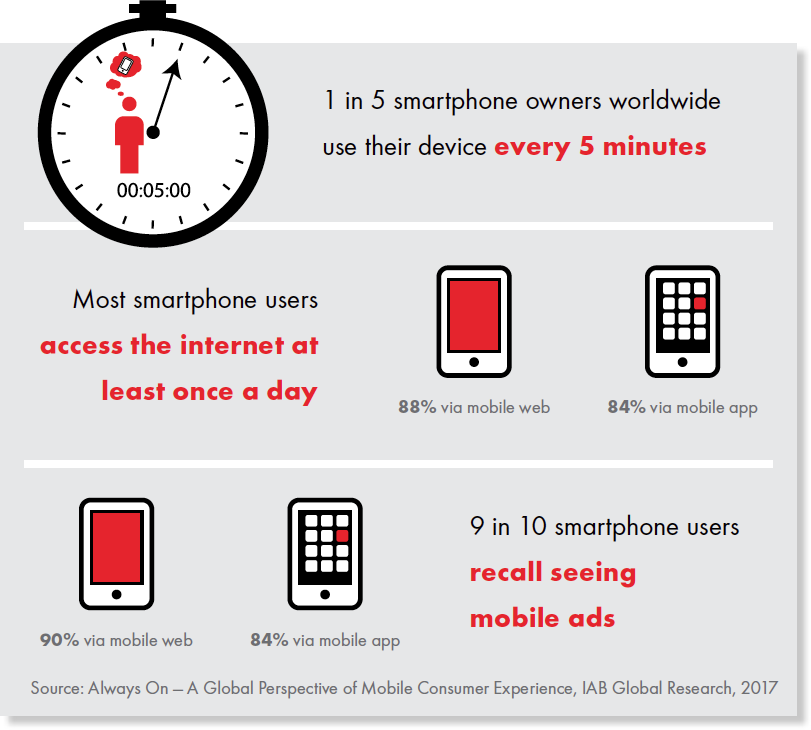
Direct-to-Consumer and Mobile Identity
Marketers are now using mobile as a direct-to-consumer pathway. To help our members thrive in a mobile-always world, the IAB Mobile Marketing Center of Excellence published The Mobile Identity Guide for Marketers (and a companion one-sheet) at the 2017 IAB Mobile Symposium in New York on June 13. The guide highlights the importance of identity management, the challenges and opportunities for leveraging identifiers such as Ad IDs, cookies, IP addresses, and location-based data, as a foundation for user-level mobile and cross-screen marketing activities, from targeting, measurement, and attribution to ensuring a quality user experience. The guide also presents use cases for identification data within two primary categories—targeting and measurement—and explores related applications that range from frequency management and audience amplification to attribution and predictive modeling.
Location-targeted mobile ad spending is forecasted to grow from $9.8 billion in 2015 to $29.5 billion by 2020. To address this growing market, IAB published in April the Mobile Location Playbook for Retail Marketers. The playbook encapsulates best practices for retailers to leverage location data for marketing and customer service throughout the consumer purchase journey. Mobile location data enhances retail marketers’ understanding of consumer behavior in the physical world, and helps reach consumers when they are in the right context, measuring marketing campaign effectiveness in driving consumers to store and connecting the dots between different marketing platforms, including TV, desktop, mobile, and Digital Out-of-Home (DOOH).
Enabling Brand Media Innovation
Surviving and Thriving in a New Direct-to-Consumer World
2017 was a year of tremendous change for many parts of the economy. As retail stores were closed by the thousands in 2017, there is a revolution in commerce underway and it’s being led by direct-to-consumer (DTC) brands with their own products that manage the entire supply chain. DTC brands such as Casper, Dollar Shave Club, and Uber, and marketers using mobile as a direct-to-consumer pathway, are disrupting the business models of market-leading brands in many categories as the world shifts from an indirect brand economy to a direct brand (and cross-screen) economy. These direct-to-comsumer strategies are the growth engine of the 21st century brand economy.
To help our members navigate this new world order, IAB has assembled a series of digital marketing resources and tools for modern marketers in the areas of audio, digital out-of-home (DOOH), and mobile.
The 2018 IAB Annual Leadership Meeting: How to Build a 21st Century Brand will also uncover marketing, data, and organizational strategies that will help brands, publishers and their partners compete in a world with nimble, tech-focused new market entrants and adapt their businesses to thrive in the 21st Century.
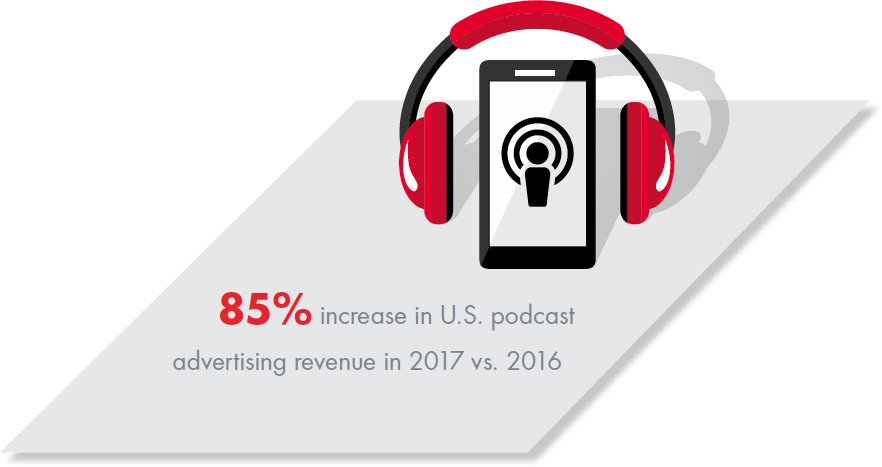 Audio and podcast
Audio and podcast
Given the growing importance of digital audio, the IAB Audio Committee once again hosted an Audio Day in early February with the goal of spurring interest in this growing advertising medium. Over 200 brand and agency marketers attended the event, which was held at WNYC’s The Green Space in New York City. The event featured four hours of informative programming on digital audio’s value proposition for marketers. Invited speakers included several high-level agency and programmatic executives. In March, the Committee also hosted a webinar titled Digital Audio’s Value Proposition. Four committee members presented key points from the Digital Audio Buyer’s Guide that had been released in November 2016. Over 200 industry executives registered for the webinar including many agency and brand marketers.
Working closely with the IAB Podcast Committee, in June, IAB released the Podcast Ad Revenue Report in partnership with PwC that provided a first-of-its-kind, data-driven revenue analysis of the largest players in the podcasting industry. Key findings included that U.S. podcast advertising revenues were forecasted to skyrocket to more than $220 million in 2017, an uptick of 85 percent over the $119 million recorded in 2016. This was on top of an impressive 73 percent annual growth between 2015 and 2016.
To provide insights into podcast audience demographics, listener behaviors, creative treatments, ad formats, delivery and targeting, and ad effectiveness measurement before this year’s Podcast Upfronts, IAB also released the IAB Podcast Playbook, the organization’s first-ever buyer’s guide for podcast advertising, This playbook serves as a go-to reference guide to help brand marketers understand podcasts and effectively steer more ad dollars toward opportunities that will deliver in terms of audience reach. In an industry where explosive growth and dramatic change have been endemic, IAB seeks to educate marketers on the unique and valuable benefits of advertising on the medium.
Digital Out-of-Home
While the connected home was once thought to be the future, it’s the connected consumer who transformed the digital environment and primed the path for digital out-of-home (DOOH). In our fragmented media landscape, billboards, transit displays, and other place-based media don’t face the same challenges as other mediums do—there’s no below the fold, changing channels, or ad blocking. Out-of-home creative is big, bold, and timely. With dynamic digital capabilities, mobile targeting, and enhanced traffic data, outdoor is more integral to the media mix than ever. In recent years, DOOH is the main driver behind the outdoor medium’s resilience, attractiveness, and performance. Its inventory has increased by 30 percent in the last two years, reaching approximately 300,000 units globally. To help publishers and advertisers make the most of this ubiquitous new medium, the IAB Digital Out-of-Home Task Force met in 2017 and released a set of case studies highlighting best practices for this important touch point in the video everywhere world.
Native Advertising
Two new initiatives are in motion for native advertising and influencer marketing as part of the newly formed Social Media/Native/Content Committee, which consists of over 500 members and met in April in New York City. Because there is confusion and complexity in the marketplace, a working group will prepare a document about native advertising buying that will provide a framework for defining and thinking about the various native advertising options from publisher-direct, to more automated offerings. Another working group is preparing documents that outline how publishers are increasingly using influencer marketing tactics to both build their editorial brand, and engage the right audience on their platforms.
Game Advertising
The IAB Game Committee was represented at the New York Media Festival (NYME) in September with a panel titled, Why Engaging Digital Ad Experiences Are the New Gold Standard for Marketers. The panel included senior leaders from Twitch, Unity Technologies, InMobi, and Zynga.
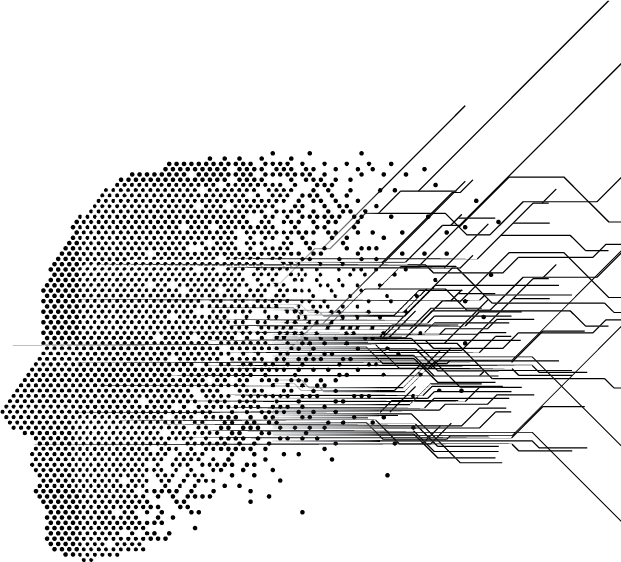 Artificial Intelligence
Artificial Intelligence
Based on significant member interest and with the goal of helping marketing, technology, and advertising executives navigate the impact AI and machine learning will have on the digital world of advertising, IAB has invited the Mobile, Native, and select Data Committee members to join the Artificial Intelligence (AI)/Machine Learning (ML) Working Group. Co-chaired by IAB Mobile Center Board Member Patrick Albano, AdTheorent, and Weather.com’s CMO, Jordan Bitterman, this group of over 100 IAB members kicked off a project in July to develop a document that seeks to demystify AI/machine learning for marketing purposes. The group will also focus on organizing tools for the industry to plan ahead for the responsible uses of AI so that humans and machines work well together into the future. Additionally, in December IAB presented an online event on the practical applications of AI for marketing.
Advancing Video Everywhere
Spurring Growth in a Rapidly Evolving Landscape
The power of sight, sound, and motion to capture attention, drive engagement, and build brands is evidenced by the continued growth in digital video advertising. Serving as the industry go-to resource for all things video, the Video Center of Excellence provides an industry perspective on the state of the digital video, a marketplace representing over $9 billion in annual ad spend with a growth rate that has surpassed display, search, and social media. The center’s mission is to help educate the advertising marketplace about the growth and value of video in reaching and engaging consumers. With a growing library of resources, from the comprehensive Guide to Digital Video Advertising, the Video Landscape Report, and the Video Glossary, the Video Center empowers buyers and sellers to grow their business, through a better understanding of how to create, measure, and monetize digital video. The IAB Digital Video Center of Excellence gathered—through its annual leadership summit—a core team of industry leaders to help prioritize issues and develop action plans to enable the continued growth of the video advertising space, which is rapidly coming to mean Video Everywhere.

The 2017 Digital Content NewFronts in May marked the fifth year that IAB has acted as Managing Partner of this real marketplace, which has become the biggest digital video event of the year and a critical component in media planning for thousands of marketers and their agency-side strategists, media buyers, and planners. Mobility was a major theme at this year’s event. We saw, for example, a striking increase in the number of NewFronts presenters offering live programming—for “live” is the lure for the mobile millennial. Another significant observation from the 33 NewFronts presentations is that Over-the-Top (OTT) video is morphing into a mainstream marketing medium. OTT video consumption in the living room is attracting all ages and demographics, creating equivalencies between upstarts and incumbent video brands, especially as younger consumers use their mobile phones as their set-top boxes and remotes, consuming digital native video, longstanding networks, and “casted” videos promiscuously in single viewing sessions.
Video Ad Spend and the Changing TV Experience
The IAB Digital Video Center of Excellence released two studies in May, in tandem with the 2017 Digital Content NewFronts. First, the fourth annual Digital Content NewFronts: Video Ad Spend Study showed original digital video is gaining a greater share of total digital video budgets, reaching 47 percent in 2017, double from 2015. And native advertising continues to be a key part in these original digital video buys, accounting for 42 percent of investment. The second report, The Changing TV Experience Study, showed that the majority of time Americans watch TV is spent streaming video. The big screen video experience is changing rapidly as 56 percent of consumers’ TVs are now IP-connected, and 54 percent of those viewers are now spending more time watching non-linear content, including digital video. And on the small screen, there’s exciting growth and advertiser demand, but also plenty of challenges as media companies and brands seek to fully leverage the mobile opportunity. DTC (Direct-to-Consumer) nimble brands also favor OTT as an advertising and storytelling platform and a great way to reach their target audiences. The key message for big screen video advertisers is that you need to be in OTT if you’re going to stay visible and relevant with on-demand, cord cutting/cord shaving consumers.
The IAB Video Center of Excellence and its members have developed a Guide to Digital Video Advertising that offers tools, tips, and guidance for publishers, marketers, and brands to understand video in its multiple current and emerging forms. Released in September, the guide is a combination web site and multi-chapter report that addresses such topics as: which formats and platforms are seeing the most growth, what works, and what’s trending for the future (including vertical video). Other chapters include a Video Ad Tech Overview (explaining the technologies and standards used to serve ads, with practical checklists for campaign execution), Audience, Data and Measurement, and Challenges in the Digital Video Space (and Efforts Underway to Solve Them), with summaries of what’s needed to ensure a more efficient marketplace. Given the speed of change, the guide will be updated on a semi-annual basis.
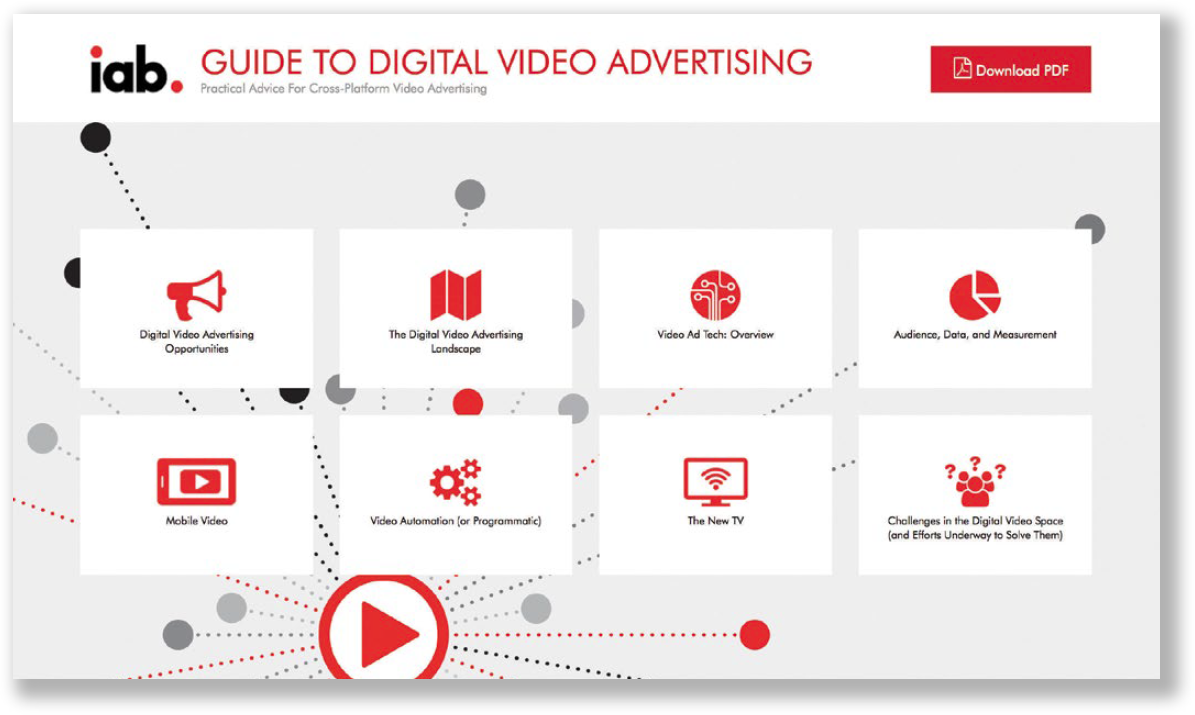
Video Landscape Report
As part of our continued effort to simplify video and educate the advertising marketplace about the growth and value of video, in November the IAB Video Center of Excellence released the second iteration of the Video Landscape Report, a collection of industry research and analysis highlighting key trends, challenges and opportunities related to addressable TV, connected TV/OTT, virtual reality (VR), vertical video, live video, esports, interactive and shoppable video, “skinny bundles,” and native formats. The report is updated twice a year to provide a snapshot of the current state of the video advertising ecosystem.
In July, the IAB Video Center hosted its annual Video Leadership Summit: Tele://Vision, an invitation-only working meeting that gathers leading industry stakeholders to address and solve problems facing the video industry. Beginning with a discussion with Chris Jacquemin (head of digital media at the Hollywood talent agency WME-IMG), participants examined the world of Hollywood disrupters, the creators and influencers driving the emerging OTT landscape. Additional themes included resources and measurement and what’s needed to support creative development across the multiscreen landscape. Issues of communication across the worlds of TV and digital were also addressed with suggestions focused on establishing a shared vernacular, buyer education, and clearer key performance indicators (KPIs) to help bridge gaps in planning, buying and selling.
The Colliding Worlds of Digital Video and TV
The growing popularity of Over-the-Top (OTT) video is shifting the traditional TV landscape, bringing interactivity, data, and targeting long associated with digital media to the television ecosystem. To build on the OTT/Connected TV research program, the IAB Digital Video Center, in collaboration with Freewheel, Hulu, and Roku, conducted a primary research study and in November of 2017 released a report called The OTT Co-Viewing Experience 2017 to focus on understanding the co-viewing behavior on OTT and its benefits to brands, such as incremental reach and advertising effectiveness. Co-viewing, long a staple of linear TV viewing, is similarly popular with viewers of OTT, DVR, and video-on-demand (VOD) programming. The study reveals that more than half (56 percent) of those co-viewing on OTT say that they regularly talk about the brands or products they see while watching content on television screens. Moreover, brand-related multitasking behaviors are particularly strong among OTT co-viewers, including chatting on social media about the brands they see, conducting brand-related searches, and even making purchases online. OTT co-viewers also spend more than double the amount of time watching ad-supported content than they do on subscription services with no ads.
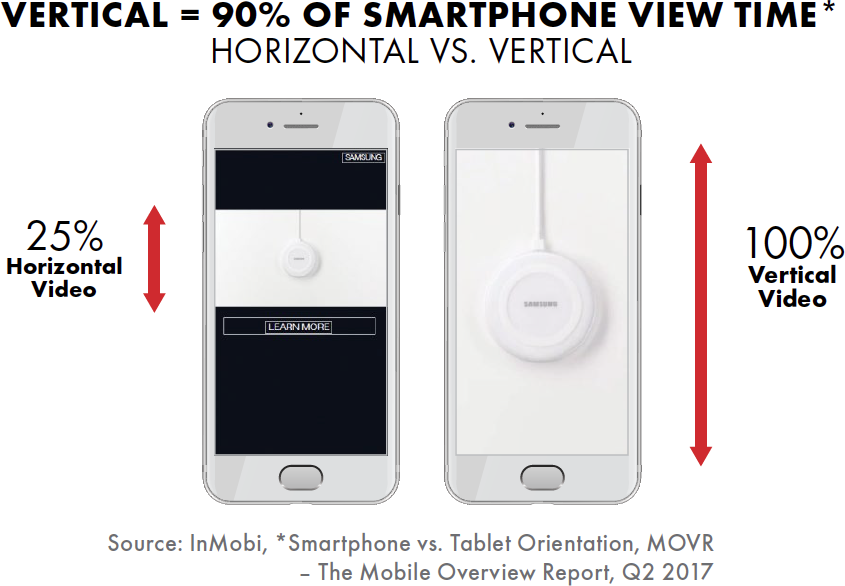
Also in November, IAB hosted a full-day Video Symposium: Video Everywhere exploring innovation and strategies for creating, distributing, measuring, and maximizing the use of video to engage consumers across platforms. In a media landscape that continues to be transformed by the confluence of technological innovations and consumer behavior shifts, one thing is clear, the general notion of a video consumer is in the midst of a rewrite. With the goal of examining the opportunities and challenges that come from operating in a complex media environment where everything is in motion, the event featured leaders from the top publishers, brands, and tech enablers who shared their first-hand experiences on key topics in the industry. There were key discussions surrounding how to monetize OTT, how to use data to understand the connected consumer and measure campaign impact, and strategies for developing OTT creative.
The Changing Landscape of Video Consumption
Driven by the popularity of apps such as Instagram, Facebook, and Snapchat, half of the advertisers interviewed for the IAB NewFronts Video Ad Spend study stated that they purchased vertical video ads in 2016. In addition, a recent study by analytics firm MOVR shows that most smart phones are being used in portrait orientation, with the most popular size showing 90 percent portrait usage. In addition, inspired by this continued growth in vertical consumption, the IAB Vertical Video Working group prepared the Vertical Video Advertising Best Practices guide that offers marketers tips and suggestions for how best to develop device and platform-specific vertical video creative that takes advantage of the opportunity for full-screen immersion.

Technical Standards for a Scalable Video Future
Nearly 10 years ago, when digital video advertising delivery looked like it would veer into a chaotic jumble of competing standards, IAB and its members crafted the Digital Video Player-Ad Interface Definition (VPAID) and Digital Video Ad Serving Template (VAST) specifications for serving video ads consistently to different digital players. The standards were rapidly adopted by advertisers and loved for their flexibility and innovation. But VPAID and VAST were developed in the pre-mobile, pre-app world and over the years, VPAID especially, began to be co-opted .for uses it was not intended for. This is why IAB is making significant moves to simplify and clean up the digital video standards landscape with updated standards. An updated standard, VAST 4.0 took a major step in 2016 to cover some of these concerns. VAST-based video ads can now be delivered to a mobile device on a 4G network in milliseconds, an instant-play experience that allows publishers and advertisers to minimize consumer frustrations while increasing render, fill, reach, and completion rates.
IAB is continuing to address issues of transparency and trust by building function specific standards (specific specs for Verification and for Interactivity) and by supporting a player-centric architecture. Going forward, the VPAID spec is being retired and will be replaced by two separate specs in development. Verification will be covered under the Open Measurement (OM) umbrella. The plan is to rely on VAST to deliver the ad, Open Measurement for verification and VAST Interactive templates for simpler/common interactive experiences to build immersive interactive experiences. Standards lead to scale, which benefits both publishers and advertisers. We are committed to greater transparency and disclosure in the digital advertising supply chain, and better user experience for consumers. Only then can digital video realize its full potential as a reliably scalable, safe, and profitable medium that also delights and engages consumers every time.
Making Measurement That Matters
Creating New Cross-Platform Currencies
The ability to count media exposures and message frequency across channels is foundational to assessing ad effectiveness and the relative contributions of individual touchpoints towards marketing objectives. IAB is committed to helping the industry define meaningful and relevant metrics across all forms and formats of media—including mobile video, native, and audio—to make cross-media planning, buying, and analysis comparable, so brand advertising budgets can flow to digital media.
IAB continues to engage with MRC (Media Rating Council), ANA (Association of National Advertisers), and 4A’s (American Association of Advertising Agencies) to move the Making Measurement Make Sense (3MS) initiative beyond viewability as it focuses on the next 3MS goal of creating common audience currency across media channels. As part of this effort, MRC together with IAB, ANA and 4A’s issued its new Digital Audience-Based Measurement Standards document in 2017. These standards build on MRC’s prior work on viewable impression measurement and the effective filtration of invalid traffic, and provide a set of recommended practices for the collection and processing of information used in the assignment of audience characteristics to impression-level data. These standards are an important and meaningful milestone for the media and marketing industry as we move together toward cross-media measurement comparability—the ultimate goal of 3MS. The adoption period for the standard is the full year of 2018.

Measuring Digital Location-Based Advertising
With ad measurement and performance under more scrutiny than ever, the Media Rating Council (MRC) issued the final version of its Location-Based Advertising Measurement Guidelines in March, a collaborative effort between MRC, MMA, and IAB. These measurement guidelines are formally in place to serve as industry guidance for the measurement of digital location-based advertising. The guidelines provide key definitions for location-based measurement terms, as well as recommended research practices and disclosures concerning the assignment of device, or user location for use in digital advertising measurements. They serve as a benchmark that companies and agencies can use if they choose to have their services voluntarily validated through an independent third-party auditing process.
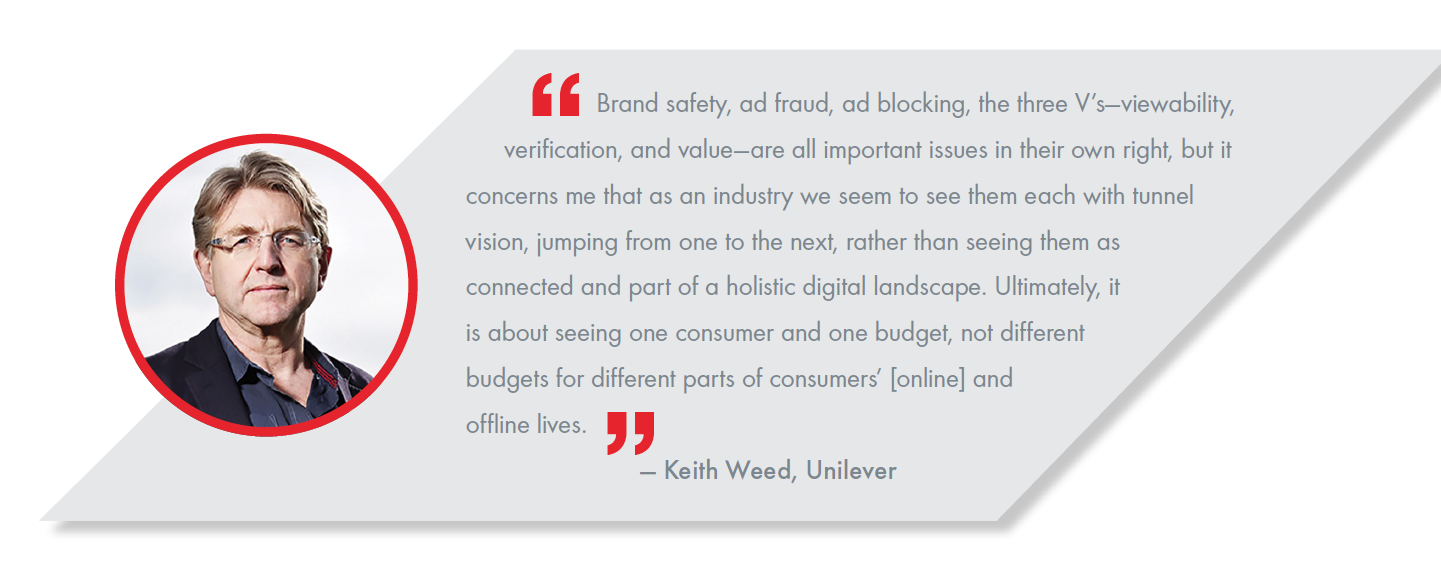
Digital Audio Ad Metrics
The Podcast Measurement Technical Guidelines establish a common set of ad metrics in the podcast space by introducing a four-step process that will help increase the accuracy of measuring podcast downloads, audience size, and ad delivery. In addition, the new guidelines provide an expanded set of podcast content metrics definitions, since podcast advertising is intrinsically tied to corresponding editorial content.
Modernizing Measurement Standards and Guidelines
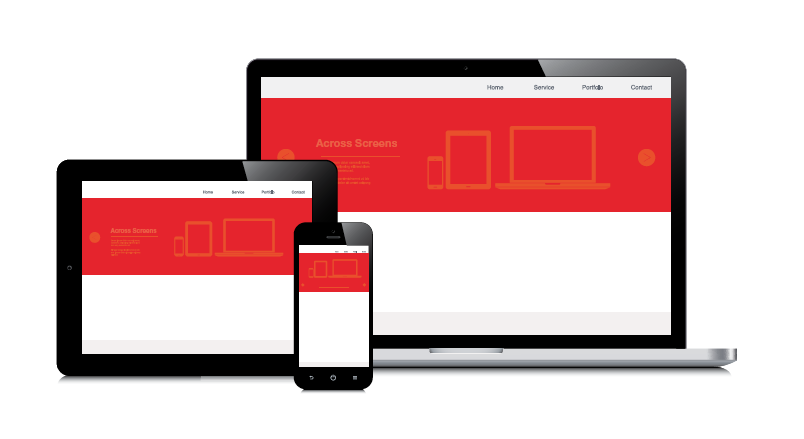 Finally, IAB is committed to eliminating confusion and reducing friction in the marketplace by developing and updating measurement standards and guidelines. The Modernizing Measurement Task Force (MMTF) released the final versions of the Mobile In-App Ad Measurement Guidelines and Digital Video Ad Measurement Guidelines, which cover the measurement and disclosures related to dynamic, in-application advertisements that appear on mobile devices, the Mobile Web Measurement Guidelines, and the Desktop Display Impression Measurement Guidelines, with the goal of defining and driving clear standards-based metrics for interactive advertising across the marketing ecosystem that are comparable to legacy media. The Open Measurement Software Development Kit (OM SDK) initiative was created to address scaling for third-party measurement of ads served within mobile app environments. In October, IAB Tech Lab announced an exciting change in the way that viewability is measured and vendors interact with mobile applications with a beta rollout of the OM SDK to the members of the Open Measurement Working Group for testing. This is an essential and important first step in introducing this SDK to market, and the beginning of a new era for the industry. We are entering an age where complex shared software frameworks will be centrally managed, with collaboration across multiple companies.
Finally, IAB is committed to eliminating confusion and reducing friction in the marketplace by developing and updating measurement standards and guidelines. The Modernizing Measurement Task Force (MMTF) released the final versions of the Mobile In-App Ad Measurement Guidelines and Digital Video Ad Measurement Guidelines, which cover the measurement and disclosures related to dynamic, in-application advertisements that appear on mobile devices, the Mobile Web Measurement Guidelines, and the Desktop Display Impression Measurement Guidelines, with the goal of defining and driving clear standards-based metrics for interactive advertising across the marketing ecosystem that are comparable to legacy media. The Open Measurement Software Development Kit (OM SDK) initiative was created to address scaling for third-party measurement of ads served within mobile app environments. In October, IAB Tech Lab announced an exciting change in the way that viewability is measured and vendors interact with mobile applications with a beta rollout of the OM SDK to the members of the Open Measurement Working Group for testing. This is an essential and important first step in introducing this SDK to market, and the beginning of a new era for the industry. We are entering an age where complex shared software frameworks will be centrally managed, with collaboration across multiple companies.
Demystifying Data
Driving Transparency and Accountability in Data
 In 2016, IAB launched the IAB Data Center of Excellence to expand existing IAB resources and drive the data agenda for the digital media, marketing, and advertising industry. The IAB Data Center of Excellence has the mission to define boundaries and to increase value along the data chain, for consumers, marketers, and the digital ecosystem that supports them, as well as to help the industry grow revenue and speed the adoption of identity standards in the marketplace.
In 2016, IAB launched the IAB Data Center of Excellence to expand existing IAB resources and drive the data agenda for the digital media, marketing, and advertising industry. The IAB Data Center of Excellence has the mission to define boundaries and to increase value along the data chain, for consumers, marketers, and the digital ecosystem that supports them, as well as to help the industry grow revenue and speed the adoption of identity standards in the marketplace.
The Outlook for Data 2017 and Beyond
Early in 2017, the IAB Data Center of Excellence partnered with the Winterberry Group for the second consecutive year in order to better understand and quantify audience data applications among digital marketing practitioners. The Outlook for Data 2017: A Snapshot into the Evolving Role of Audience Insight is a data benchmarking survey (released during the IAB Annual Leadership Meeting at the end of January) that provides a state of the union perspective that practitioners can use to benchmark their current efforts and plan for the year ahead. Among the findings:
- Better reporting, measurement or attribution was the top industry issue in 2017—a shift from 2016, when cross-device audience recognition took the lead position.
- Cross-channel measurement and attribution will occupy the most time and resources in 2018. This is notable progress from 2016, when general audience analytics demanded the most attention—highlighting increasing sophistication across the industry.
- Two-thirds of companies surveyed (67 percent) increased their spending on data and related services from 2015 to 2016, and even more (71 percent) anticipated bigger budgets in 2017, reflecting the continued importance of data in our industry.
Speeding the adoption of identity standards
Over the next decade, everything will be connected; and to understand that connection across people, places, and things, the industry needs clearer identity standards to gain consumers’ trust. With much more sensitive consumer information being used and shared, the industry needs a leader to create the rule sets and guardrails that will ensure innovation and growth. To help buy-side practitioners navigate the political and operational challenges of transitioning away from last-touch attribution strategies, the IAB Data Center released a new Attribution Hub, which was developed to provide a centralized resource that consolidates and organizes all attribution related guidance IAB has developed across its various verticals and working groups. Additionally, the IAB Data Center of Excellence Board voted to approve work on identity standards and services, as well as data market sizing. An Identity Standards and Services Working Group was formed to define best practices around user-level identity sourcing and normalization—a central step to addressing measurement, attribution, and consumer privacy needs. These standards, developed in partnership with the IAB Tech Lab, will be a foundation for technical services, which then enable improved identity solutions across the industry.
Sizing the Data Market
In December, the Data Center of Excellence and the Data and Marketing Association (DMA) released the first-ever market sizing benchmarks for data-related investment across classes and types. Called The State of Data 2017, a study showing that U.S. companies will have spent $10.05 billion on third-party audience data in 2017 for advertising and marketing efforts. However, slightly more— $10.13 billion—will have been spent on third-party solutions to support its activation. Compiled by Winterberry Group and based on an analysis of financial information provided by a range of the nation’s leading commercial data providers, the research shows that of the money spent on third-party solutions, $4.3 billion is expected to be spent in 2017 on supporting data integration, processing, and hygiene. These types of services help maximize the accuracy and actionability of audience data, while providing contextual brand safety. The report was released at the IAB Data Symposium in New York City and demonstrates that modern marketers are strategically investing in solutions to ensure their third-party data is not only ethical and secure, but also effective and accurate. The Data Center expects to build on this seminal research in 2018 by working with publishers, brands, and other stakeholders to ensure that they have the skill sets and insights necessary to take full advantage of the audience data they collect and acquire.
Data Rockstar Awards 2017
Also in December at the Data Symposium, IAB and the IAB Data Center of Excellence announced the winners of the second annual IAB Data Rockstar Awards. The awards recognize outstanding work being done by data industry practitioners, encouraging greater interest in the dynamic field of data science. Winners were selected by the Data Center Board of Directors and were evaluated based on demonstrated excellence, creativity, or forward-thinking approaches to solving problems in data science, as well as the impact their contributions have made to their team, company, or the industry as a whole.
The five winners of the 2017 IAB Data Rockstar Awards and the winner of the IAB Data Rising Star are:
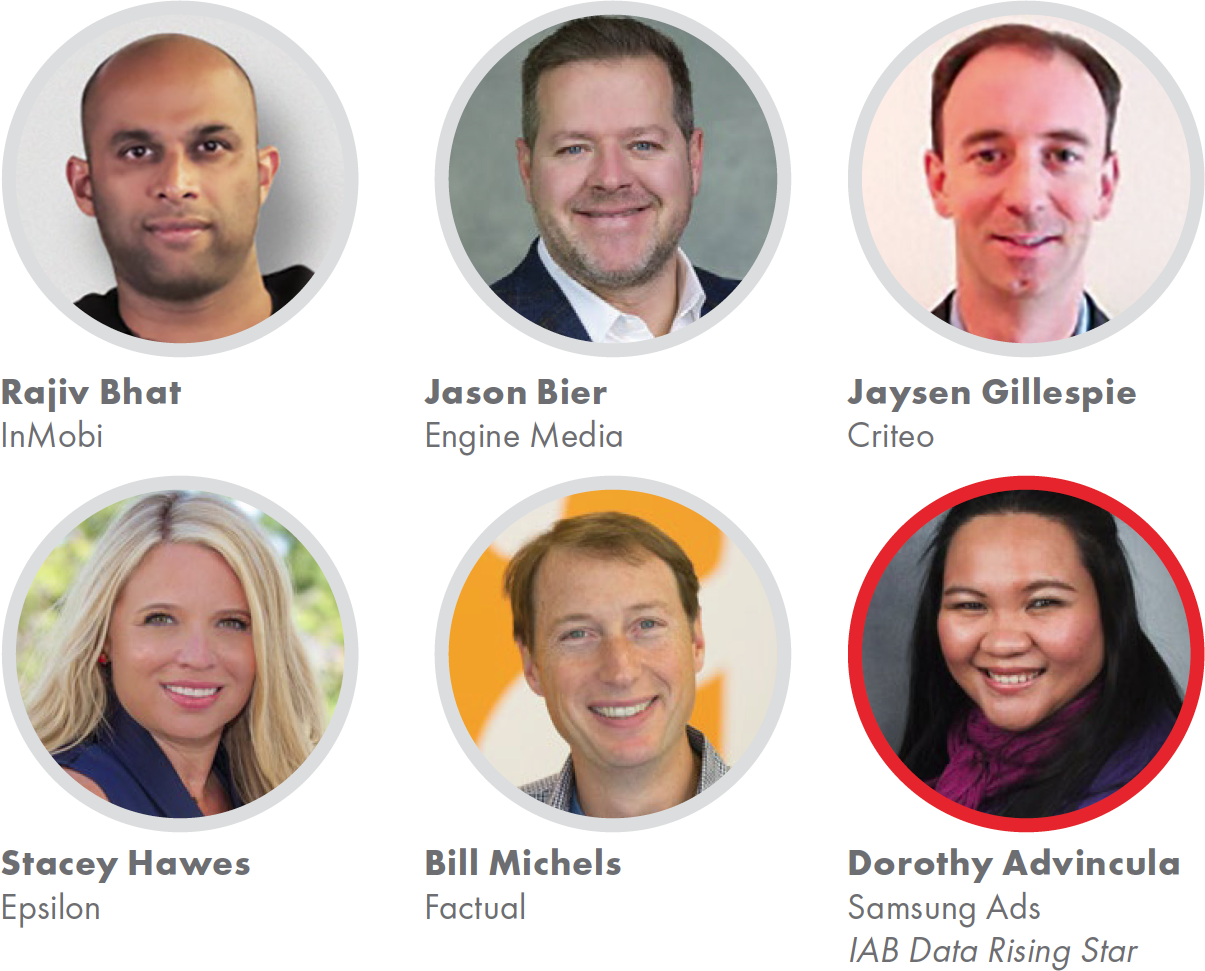
This year, IAB and the IAB Data Center of Excellence also presented the first-ever IAB Data Rising Star Award, won by Dorothy Advincula, Research and Insights Lead, Samsung. The IAB Data Rockstar Awards were created to acknowledge the importance of leadership in data science—and to highlight the ongoing need for exceptional talent in the space. These award winners represent the best-of-the-best in the dynamic arena of Big Data and play key roles in ensuring that digital marketing delivers powerful results for brands and consumers alike.
Transforming for the Next Generation of Audience Marketing
Finally, the IAB Measurement & Attribution Committee continued its focus in 2017 on buy-side multitouch attribution (MTA) guidance with the issuance of a primer on key considerations and evaluation criteria for MTA providers. This overview document is intended to help practitioners better understand the different types of data collection platforms at their disposal, their key value propositions, and how MTA analysis requires the aggregation of certain types of measurement inputs to function effectively. Using this as a reference point, readers will have a much more informed understanding of the key questions to ask MTA providers when evaluating their capabilities.
Defining New Standards, Software, and Services
The IAB Technology Laboratory is a nonprofit research and development consortium charged with producing and helping companies implement global industry technical standards and solutions for the digital media and advertising industries. The IAB Tech Lab produces and provides standards, software, and services to drive growth of an effective and sustainable global digital media ecosystem—from sell side to buy side. In 2017, the Tech Lab made real progress towards our collective goals.
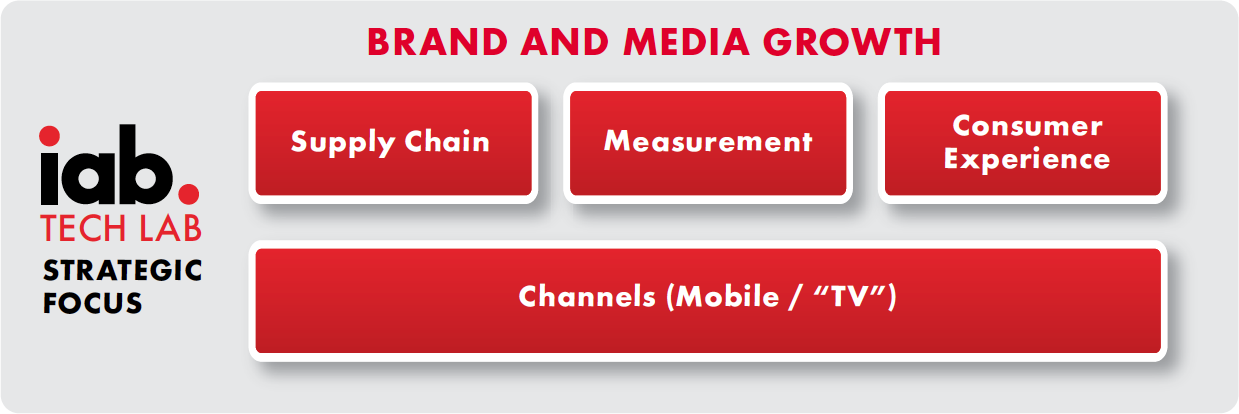
Supply Chain
Building a transparent, safe, and effective digital supply chain for improved brand and consumer safety:
- Ads.txt – the simple mechanism to identify Authorized Digital Sellers
- OpenRTB 3.0 – a new framework (in public comment) for increased security, transparency, and authentication in automated (programmatic) advertising
- Support for the Trustworthy Accountability Group anti-fraud and anti-malware initiatives and TAG ID to support transparency and safety
- Projects in progress to develop standards for identity resolution/management and data quality/integrity
- A new working group just launched to prioritize education, testing, and standards work related to blockchain
Measurement
The IAB Tech Lab enables simpler and more consistent measurement:
- Open Measurement SDK to address challenges in scaling third-party measurement of viewability and other attributes of ads and users within mobile app environments
- Podcast Measurement Guidelines to define standard metrics for both podcast content and podcast ads, and provide technical guidance for server-side measurement
- Updated click and impression measurement guidelines, as part of the Modernizing Measurement initiative, working with MRC and others
Consumer Experience
Our initiatives support improved user experiences, especially for video and native:
- The IAB New Ad Portfolio, based on HTML5 technology for mobile, display, and native formats, follows the LEAN principles (Lightweight, Encrypted, AdChoice-Supporting, Non-intrusive advertising), and also includes guidelines for new digital content experiences such as augmented reality (AR), virtual reality (VR), social media, mobile video, emoji ad messaging, and 360-degree video ads
- Dynamic Content Ad Sandards to help creative developers, ad content management systems, and ad servers build and serve real-time dynamic content in advertisements
- Defining a LEAN Seal program, so players throughout the ecosystem can attest to their alignment with these critical principles (launching in 2018)

Channels (Mobile/“TV”)
We provide members with updated standards, specs, and actionable tools to facilitate transactions and automated processes, with a focus on mobile and TV/video channel enablement:
- Mobile Rich Media Ad Interface Definitions (MRAID) version 3.0 and MRAID Ads SDK Tester
- Digital Video Ad Serving Template (VAST) version 4.0 and VAST Tag Validator
- Substantive progress in addressing evolution of the ATSC standard, file formats, and metadata to facilitate connected TV and OTT platforms and the overall transition of TV to digital
These efforts are just highlights of the progress IAB Tech Lab has made with the support of our members.
Standards in a Global Context
Borders do not confine digital, and the steps the industry is taking to improve the advertising experience for consumers continue to be seen well across Europe. Publishers in countries such as France, Sweden, Germany, the Netherlands, and the U.K. have taken ad-blocking and user experience best practices into action, actively engaging with their users and continuing to work with the IAB Tech Lab. The IAB New Ad Portfolio has also been embraced by IAB Europe’s Brand Advertising Committee and representatives from the IAB Global Network at the IAB Global Summit, ensuring a global scope and adoption.
Overall, 2017 marked a continued growing spirit of collaboration in the international marketplace with great opportunity for publishers, marketers, and agencies to participate in driving the industry forward. IAB plans continued activities in all these countries and across borders in 2018 and beyond to help government entities understand which regulations can be good for the industry and to promote responsible growth.
IAB Tech Lab Compliance Program
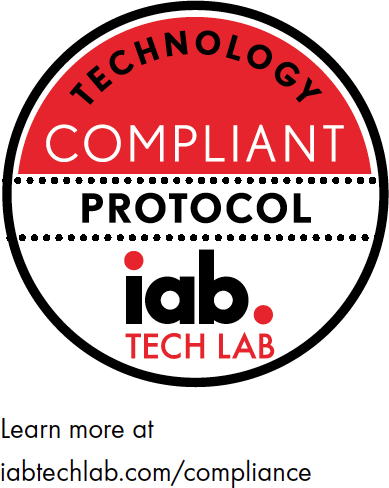 The IAB Tech Lab has launched the Technology Compliance Program, a system for auditing and formally validating companies’ use of critical industry standards. Becoming an IAB Tech Lab Compliant Partner means you’ve joined an elite group of industry leaders who share common goals including:
The IAB Tech Lab has launched the Technology Compliance Program, a system for auditing and formally validating companies’ use of critical industry standards. Becoming an IAB Tech Lab Compliant Partner means you’ve joined an elite group of industry leaders who share common goals including:
- Driving efficiency in our complex ecosystem
- Influencing the growth of standards that align with cost saving, effectively increasing your bottom line
- Spending more time on advancing platforms when selecting partners who are compliant
- Using your IAB Tech Lab Compliance as proof that you are compliant and expect the same from your partners
Championing Diversity & Inclusion
Building a Diverse Talent Pipeline for the Digital Workforce
 A healthy and sustainable digital industry needs a talent pipeline that reflects the audiences it serves. IAB continues to champion this goal with the IAB Education Foundation, a 501(c)(3) charitable non-profit organization, dedicated to tackling the growing talent and skills gap and increasing gender, racial, cultural and economic diversity in the digital marketing and advertising industry. iDiverse, the Education Foundation’s marquee education initiative, is committed to creating a pipeline of diverse and skilled professionals to ensure the continued health and vibrancy of the digital industry, through training, mentoring, recruiting, and workforce development.
A healthy and sustainable digital industry needs a talent pipeline that reflects the audiences it serves. IAB continues to champion this goal with the IAB Education Foundation, a 501(c)(3) charitable non-profit organization, dedicated to tackling the growing talent and skills gap and increasing gender, racial, cultural and economic diversity in the digital marketing and advertising industry. iDiverse, the Education Foundation’s marquee education initiative, is committed to creating a pipeline of diverse and skilled professionals to ensure the continued health and vibrancy of the digital industry, through training, mentoring, recruiting, and workforce development.
The Digital Talent Pool
As a cornerstone of our policy and research effort, this year IAB released the third iteration of our ground-breaking study: The Economic Value of the Advertising-Supported Internet Ecosystem. The research found that digital advertising propelled $1.1 trillion into the U.S. economy in 2016, and is responsible for 10.4 million jobs in the U.S., accounting for 7.3 percent of the country’s total nonfarm employment. To help fill the talent gap, the IAB Education Foundation, following up on the commitment the organization made to diversity and inclusion three years ago, has added qualified diverse talent to the industry’s employment pipeline through its iDiverse initiative.
Multicultural Best Practices
The shift of the digital ad audience for the multicultural demographic has far outpaced the demographic shift of the ad industry: Today, more than 40 percent of the U.S. population are diverse, non-white Americans. To support our members in this important opportunity, the IAB Cross-Cultural Marketing Day: “Our America Is Multicultural So Is the Opportunity.” was held on October 10 at Oath offices in New York. The event featured speakers from Kimberly-Clark and Ipsos, as well as discussions of approaches for addressing the “majority minority,” how companies, agencies, and marketing teams are organizing for success, and the increasing importance of quality data and consumer insights. Client-based case studies were shared throughout the day.
Promoting Education, Diversity, and Development

The Education Foundation is working hard to deliver a diverse talent pool that reflects the audiences we serve by adding qualified diverse talent to the industry’s employment pipeline through its iDiverse initiative. The iDiverse education program is an in-depth four-month training program, developed by leading industry experts, that prepares a diverse group of enrollees for jobs in digital media, marketing, sales support, and data analytics. Students coming out of the program have a core knowledge of the industry and are prepared for entry level jobs. Graduates of the program are eligible to take the IAB Digital Marketing and Media Foundations Certification exam, further solidifying their knowledge of the ecosystem. By hiring iDiverse graduates, you’re hiring a highly credentialed, entry-level candidate, ready to make an impact at your company.

Qualified Candidates Looking for Jobs in Companies Like Yours
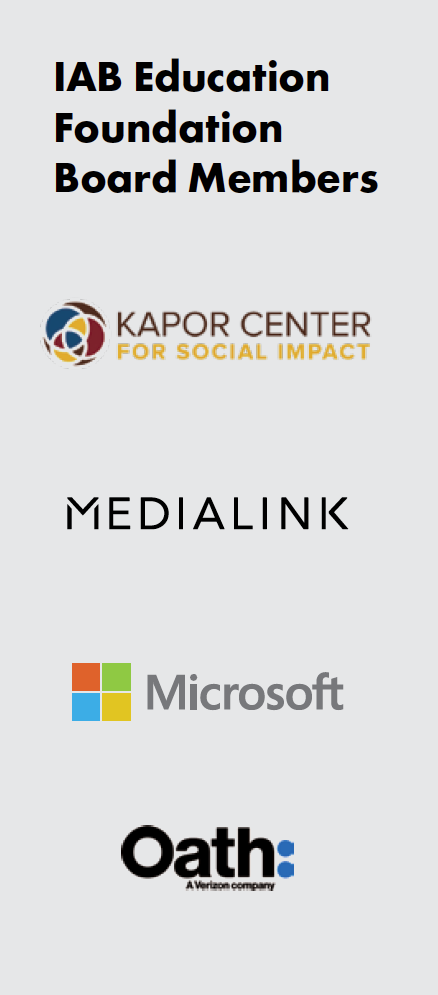 We are now proud to claim 70 graduates from our iDiverse Digital Marketing and Media Foundations Program on both the East and West coasts. Our first New York City cohort with the Borough of Manhattan Community College (BMCC) graduated from the iDiverse Digital Marketing and Media Foundations Program in October. And we now have three student cohorts who graduated from the College of San Mateo (CSM) in the Silicon Valley. Program graduate profiles can be found by visiting idiverse.org/students.
We are now proud to claim 70 graduates from our iDiverse Digital Marketing and Media Foundations Program on both the East and West coasts. Our first New York City cohort with the Borough of Manhattan Community College (BMCC) graduated from the iDiverse Digital Marketing and Media Foundations Program in October. And we now have three student cohorts who graduated from the College of San Mateo (CSM) in the Silicon Valley. Program graduate profiles can be found by visiting idiverse.org/students.
We encourage our members to show support by hiring these qualified candidates, by joining our board of directors, and/or supporting and funding our program initiatives.
Diversity & Inclusion Task Force
The Diversity & Inclusion Task Force met in October for a lively discussion presented by Education Foundation board member Freada Kapor Klein of Kapor Center for Social Impact on Why Diverse Employees Leave Tech and What to Do About It. Tim Armstrong, CEO, Oath, sat down with two of our newest iDiverse graduates to hear their perspective on why they took the Digital Marketing and Media Foundations course, what they hope to do now that they have finished, and why they are interested in joining the digital marketing industry. We also hosted a “Career Accelerator” event in NYC on November 6 for the graduates of our iDiverse program, asking Hiring Managers, D&I Professionals, and HR representatives to lend their expertise and meet our students.
IAB Education Foundation Board
Under the leadership of the IAB Education Foundation Board Chair and Oath CEO Tim Armstrong, the board met in October and discussed the expansion of the program and ways to bolster hiring initiatives. We urge our members to show their support as a thought leader in diversity by joining our board of directors and supporting our initiatives.
As we were going to press with this year’s annual report, IAB was humbled and honored to learn that the IAB Education Foundation and Randall Rothenberg have been inducted into the Diversity Hall of Honors at the inaugural Advancing Diversity Honors event held during CES on January 10 in Las Vegas. It’s an affirmation that the IAB Education Foundation is uniquely positioned to connect the stakeholders that understand the looming skills gap and human capital problems facing the interactive industry—so we can all work together to solve them.
Accelerating Career Growth
Certification Programs and Professional Development
As the digital media and advertising industry has grown, IAB members have asked for more training programs to build the talent pool by improving skills in the digital media and advertising industries and expanding certification programs in sales, data solutions, and ad operations. The IAB Certification Program continues to expand in size and global recognition. In 2017, digital leaders have taken part in the Sales, Ad Operations, and Data programs across 73 countries, bringing the total number of participants in the program to more than 14,820.

Programmatic Decoded
The industry is changing quickly and IAB has continued to introduce new certifications and retool older ones to reflect the changes in technology and the industry. In 2017, IAB launched a new training program called Programmatic 360: Automation Decoded, an exclusive, comprehensive training for buyers and sellers that provides in-depth knowledge of programmatic technologies. IAB also launched the online counterpart to our Programmatic 360: Automation Decoded in-person course, which already reached more than 150 learners in cities across the U.S. in 2017. The online course is highly interactive with live discussions and demos from industry experts, providing technical know-how and best practices for buyers and sellers. Responding to high demand for this training, the course will be available online globally.

Marketing and Media Foundations Certification
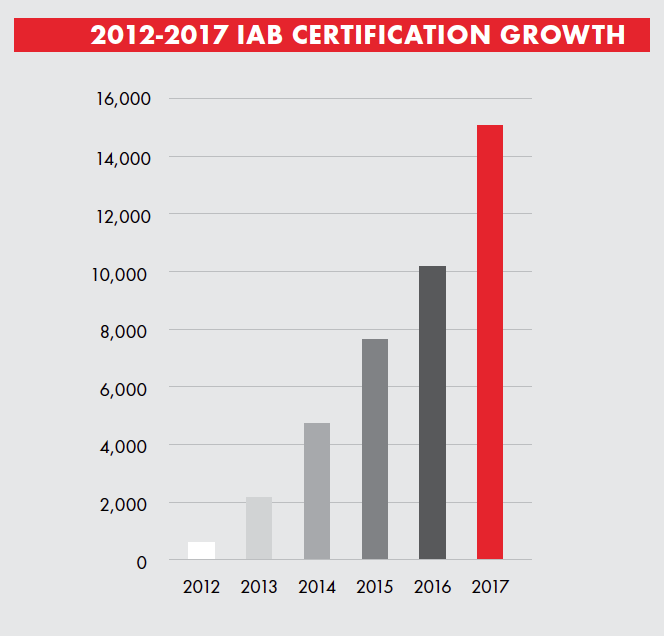 IAB also introduced the IAB Digital Marketing and Media Foundations Certification, the only globally recognized professional certification created specifically for digital media and advertising. This program is for those new to the digital spectrum, and provides a solid understanding of the digital marketing and media ecosystem, while helping candidates build their careers and secure jobs in a range of digital advertising departments—from media buying to selling, ad operations, data solutions, marketing, and more.
IAB also introduced the IAB Digital Marketing and Media Foundations Certification, the only globally recognized professional certification created specifically for digital media and advertising. This program is for those new to the digital spectrum, and provides a solid understanding of the digital marketing and media ecosystem, while helping candidates build their careers and secure jobs in a range of digital advertising departments—from media buying to selling, ad operations, data solutions, marketing, and more.
IAB Digital Media Seller Intelligence Study
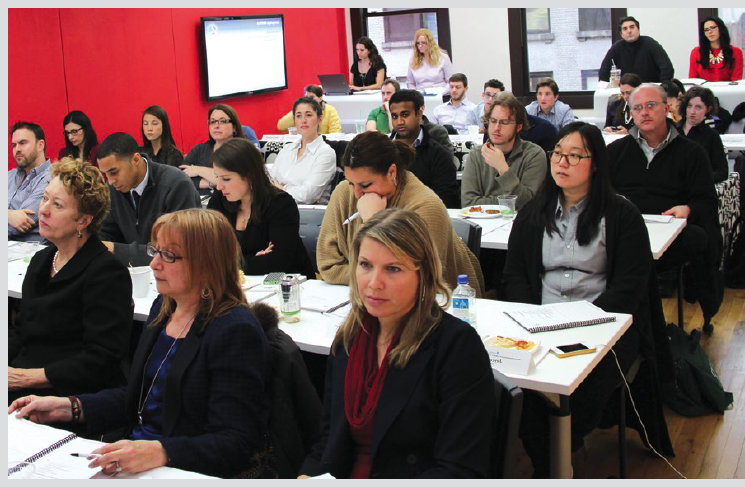 The IAB Digital Media Seller Intelligence Study is the first-ever benchmarking research at the industry level to understand the impact of training and certification on performance and career prospects. This important study synthesizes both qualitative and quantitative insights—collected from digital media sales leaders and digital media sales professionals—to inform the development of best practices for training and development as a tool set for the leaders of digital advertising sales organizations to develop their teams, and for individual digital media sales professionals to develop their own individual career paths.
The IAB Digital Media Seller Intelligence Study is the first-ever benchmarking research at the industry level to understand the impact of training and certification on performance and career prospects. This important study synthesizes both qualitative and quantitative insights—collected from digital media sales leaders and digital media sales professionals—to inform the development of best practices for training and development as a tool set for the leaders of digital advertising sales organizations to develop their teams, and for individual digital media sales professionals to develop their own individual career paths.
The ongoing demand from members for IAB learning and certification programs is a validation of how important training is for the industry as a whole to extend the talent pipeline and our commitment to ensuring members’ needs are being met.
Our Members
The IAB mission is to empower the media and marketing industries to continue to thrive in the digital economy, and helping you—our members—is how we strengthen those industries. In 2017, IAB reconfigured its internal structure in order to better serve its members. With a focus on servicing key accounts and implementing systems to fully engage members with white-glove service, IAB now dedicates a single point of contact to every member. We also conduct ongoing qualitative and quantitative research to uncover unmet member needs, refocus our IAB priorities, and inform staff about best practices for servicing members effectively.
IAB membership now includes more than 650 leading media and technology companies. The Long Tail Alliance—our body representing smaller developers of original digital content, including bloggers and other sites with less than $1 million in annual revenues and fewer than five full-time employees—now includes 1,190 members. Together, they account for 86 percent of online advertising in the United States. We thank all of our members for their support throughout the year.
New General Members
AdBrilliant
Addapptr
Adrizer
Albert
Amino Payments
Anghami
Appodeal
Art19
Audio Network
Audioboom
Beeswax
Blis
Botworx.ai
Bringhub
Cadent Technology
Cheddar
Cignal.io
Deluxe
Dianomi
DMD Marketing Corp.
DMG DSNR Media Group
Engine Media
Evo Clip USA
FORTVISION
Gameloft
Genius Monkey
Gimlet
Inoventiv
ION Media Networks
Jukin Media
Kiip, Inc.
Konduit
LiquidSky Software
LKQD
Market Enginuity
MightyHive
MUNDO Media
Newbase
NextVR
NGL Media
Nucleus Marketing
Ogury
OpenSlate
Outcome Health
Pacific Content
Panasonic Avionics
Parrable
Placecast
Placed
Premion
Publica
rewardStyle
Screen6
Sentient.ai
Shazam
SoundCloud
Spaceback
SpringServe
Tapgerine
Teemo
Topix
TuneIn
Verse
Vertoz
Vice Media
Webspectator
General Members
33Across
4C
4INFO
A+E Networks
AARP
AccuWeather
Activision Blizzard
Acxiom
Adacado
ADARA, Inc.
Adbrain
AdBrilliant
AdColony
Addapptr
Adform
AdGear Technologies, Inc.
AdLarge Media
adMarketplace
Adobe
Adrizer
AdRoll
Adslot
AdSpirit
Adswizz Inc
Adtegrity
AdTheorent
Adversal.com
Adyoulike
Adzerk
AerServ
Affinity Express
ALC
Alliant
Alphonso Inc
Altice USA
Amazon
AMC Networks
American City Business Journals
American Media, Inc.
American Public Media
Amobee
Anghami
Aniview
Anyclip
AppNexus
Appodeal
Art19
AT&T AdWorks
AudienceScience
Audioboom
Audio Network
BabyCenter
Bazaarvoice
BBC Worldwide Americas
Beachfront Media
Bidtellect
Blippar
Blis
BlogTalkRadio
Bloomberg
Bounce Exchange
Brightcove
Bringhub
BroadSign
BuzzFeed
C1 Exchange
Cable One Advertising
Cadent Technology
Cars.com
CBS Interactive
CBS Local
Celtra
Centro
Charter Communications
Cheddar
Cignal.io
Clear Channel Outdoor
Clipcentric
Comcast Spotlight
Complex Media
Condé Nast
Connatix Native Exchange
Conversant Media
Core Audience
Cox Enterprises
Crain Communications
Criteo
DailyMail.com/Elite Daily
Dailymotion
DashBid
DataXu
DAX U.S.
Defy Media
Demandbase
Dianomi
Digilant
Digital First Media
Digital Remedy
Discovery Communications
DISH
Disney Interactive
District M
DMD Marketing Corp.
Dominion Digital Media
Dotdash
Drawbridge
Dstillery
eBay
Eko
Electronic Arts
eMarketer
Emogi
Engine Media
Entravision
Epsilon
Equinix
eXelate
Expedia Media Solutions
Experian Marketing Services
Extreme Reach
Eyeota
eyeReturn Marketing
Eyeview
Factual
Fandom powered by Wikia
Feature Forward Ltd.
Flashtalking
Fluent
Forbes Media
Foursquare
Frankly Media
FreeWheel
Fullscreen, Inc
Fyber
Gameloft
GasBuddy.com
Genesis Media
Genius Monkey
Gimbal
Gimlet
Goodway Group
Grapeshot
Groundtruth
Gruuv Interactive
GumGum
Hanley Wood
Harvard Business Review
HealthiNation
Hearst Magazines Digital Media
HIRO-Media
Homes.com
Hulu
iHeartMedia
Index Exchange
INFORM
InMobi
Innity
Innovid
Inoventiv
Intersection
Investor’s Business Daily
ION Media Networks
IPONWEB Inc
IRI
Jivox
JUICE Mobile
Jukin Media
Jun Group
JW Player
Kantar Media
Kargo
KBM Group
Kiip, Inc.
Kochava Inc.
Leaf Group
Legacy.com
Libsyn
Liquidus
LiveIntent
Live Nation
LKQD
Lo70s
Lonely Planet
Lotame Solutions
LotLinx
Madison Logic
Magnetic
Mansueto Ventures
Marchex
Market Enginuity
Markit Digital
Mashable
Match Media Group
Matomy Media
MaxPoint
Media.net
Media iQ Digital Ltd
MediaMath
MediaOcean
Mediative a division of Yellow Pages DMS Limited
Medicx Media Solutions
MeritDirect, LLC
MGID
Microsoft Advertising
Mixpo
MONSTER
Morningstar
Multiview
MUNDO Media
my6sense
NASCAR Digital Media
National Football League (NFL)
National Public Media
Nativo
NBCUniversal
NCC Media
Netmining
NetSeer
Neustar
Newbase
News Corporation
New York Public Radio
Nexstar Digital
Nexstar Media
NextVR
NGL Media
NinthDecimal
Nucleus Marketing
Oath
Ogury
Ooyala
OpenSlate
OpenX
Optimatic
Oracle
Orange142
Outbrain
Outcome Health
Outfront Media
OwnerIQ
Pacific Content
PadSquad
Panasonic Avionics
Pandora
Parrable
Parsec Media
PCH/Media
PGA TOUR
Pixability
Pixalate
Placecast
Placed
PlaceIQ
Platform Inc
PodcastOne
Podtrac
Polymorph
POPSUGAR
Positive Mobile
PowerLinks Media
Prisa Digital
Programmatic Mechanics
Public Media Marketing
PubMatic
PulsePoint
Purch
PushSpring
Quantcast
Quotient
Rakuten Marketing
RawVoice
Realvu
Receptiv
Refinery29
Resonate Insights
Reuters
RevJet
rewardStyle
RhythmOne
Rocket Fuel
Roku
Rubicon Project
RUN
Salesforce Marketing Cloud
Samsung Electronics America, Inc.
SAS Institute
Screen6
Scripps Networks Interactive
Semcasting
Sentient.ai
ShareThis
Sharethrough
Shazam
SheKnows
Signal
Simpli.fi
SITO Mobile
Sizmek
Skimlinks
Slate
Smaato
Smart AdServer
SmartyAds
Snapchat
Sonobi
Sony Pictures Television
SoundCloud
Sovrn
Speed Shift Media
Spongecell
Spotify
SpotX
Springer Nature
SRAX
StartApp
SteelHouse
Strategy+Business
Stuff Media
Sublime Skinz
SundaySky
Swoop
Synacor
Taboola
Tapad
Tapgerine
TargetSpot
Taunton Interactive
Teads
Tech Mpire
Telaria
Terra Networks USA
The New York Times Company
TheStreet.com
The Trade Desk
The Weather Company, an IBM Business
Thinknear by Telenav
Time Inc.
Topix
Torrential
Tremor Video DSP, Inc.
TreSensa
TripAdvisor
TripleLift
Triton Digital
Trivver, Inc
Tronc
true[X] inc.
TruEffect
Trusted Media Brands
TuneIn
Turner Broadcasting System
Twitch
UberMedia
Ubimo
Undertone
Unity Technologies
Univision
Unlockd
Uproxx
USATODAY.com
US News & World Report
V12Data
Valassis
Vdopia
VertaMedia
Vertoz
Verve
VEVO
Viacom
Viant
Vibrant Media
Vice Media
VideoAmp
video intelligence AG
Videology
Vidillion
ViralGains
Visa Advertising Solutions
Visible Measures
Visto
VIX
Warner Bros. Digital Media Sales
Washington Post Digital
WebMD
Webspectator
Westwood One
WideOrbit
Wiland
Wondery LLC
Worldata
WWE
XappMedia, Inc.
Xaxis
XUMO
YellowHammer Media Group
Yieldmo
YP
ZEDO
Zefr
Zergnet
Ziff Davis, LLC
ZUMOBI
Zynga
ZypMedia
New Associate Members
Cielo24
Confiant
Critical Mix
Cuebiq
Dentsu Aegis
FusionSeven
GenerationIM
Geopath
Gregory Welteroth Advertising
HCL technologies
Mars
Media Japan Network
Mortgage Solutions of Colorado, LLC
OMD
SimpleReach
Universal Parks & Resorts
VSA Partners
Associate Members
Active International
Ad-iD
ADLOOX
Advertiser Perceptions
Affinio
AIG
Alliance for Audited Media (AAM)
Archer Advisors
Bartle Bogle Hegarty
Bionic Advertising Systems
Bonzai
BPA Worldwide
BrightLine
Burt
CDK Digital Marketing
Cielo24
Cisco
Coalition for Innovative Media Measurement (CIMM)
comScore
Confiant
Critical Mix
Crowdtap
Cuebiq
Deloitte & Touche, LLP
Dentsu Aegis
Dieste
DoubleVerify
Dun & Bradstreet
DWA Media
Ericsson
Ernst & Young
eZanga.com
Forensiq
FusionSeven
GenerationIM
GeoEdge
Geopath
GfK North America
Ghostery
Good Apple Digital
Gregory Welteroth Advertising
GroupM
Havas Media
HCL technologies
iCrossing
Infinitive
Instart Logic
Integral Ad Science
Intel
iOPEX Technologies
IPG Mediabrands
Johnson & Johnson
Magna Global
MarketStar
Mars
Maru/Matchbox
Media Japan Network
MediaLink
Media Management Inc.
Media Rating Council
Merkle
Millward Brown Digital
Moat
Monotype
Mortgage Solutions of Colorado, LLC
Nestle Purina Pet Care
Netflix
News Media Alliance
Nielsen
OMD
Outsourced Ad Ops
Pebble Post
PIVnet
PMX Agency
PricewaterhouseCoopers
Prohaska Consulting
Redbooks
ResponsiveAds
RiskIQ
Rokkan Media LLC
Sales Athlete Media Network
Sensewhere
SimpleReach
SQAD
Standard Media Index
Szabo Associates, Inc
Taco Bell
Television Bureau of Advertising
Teralytics
The Center For Sales Strategy
The Media Trust Company
Theorem
TiVo Research
Unilever
Universal Parks & Resorts
Varick Media Management
Visual IQ
VSA Partners
White Ops
Winterberry Group
Zentrick
zVelo
IAB Tech Lab Members
All IAB U.S. general members are automatically members of the IAB Tech Lab. Additional members include:
Baverianvine
Bitposter
Blockthrough
Blue 449
ComboGuard
Cyberagent, Inc.
Cyber Communications Inc.
Digital Advertising Consortium Inc.
DigiTrust
FRECKLE IoT
Happy Punk Panda
Improve Digital International B.V.
Intowow
JCDecaux
Kr8os
Ligatus
Mediasmith
MetaX
Miaozhen Systems
Momentum
Monotype
PageFair
Papyrus
Publicis Groupe
Spark Foundry
Starcom Worldwide (Publicis)
TenMax
VM1
Weborama
Yahoo Japan Corporation
YOSPACE
Zenith Media
2017 Committees and Councils
IAB helps drive the industry forward through the efforts of committees and councils in various industry segments. These groups include the brightest minds in the industry gathered to develop solutions that improve the interactive advertising and marketing ecosystem for everyone. There are currently more than 20 IAB committees and councils and more than 50 working groups and task forces. In 2017 we also introduced an Investment & Relations team to prioritize IAB resources on initiatives with the most impact for our members’ growth and the overall health of the industry.
IAB committees are based on specific platforms within the digital advertising medium. Committee members work together to prove platform value or simplify the processes for buying, selling, and creating interactive advertising.
IAB councils are based on specific industry roles within members’ organizations. Council members share best practices and develop tools to improve efficiency, provide thought leadership, and grow digital advertising.
COMMITTEES AND COUNCILS
Doug Fleming, Hulu, Co-Chair
Adam Lowy, DISH, Co-ChairAudio Committee
Mike Agovino, PodcastOne, Co-Chair
Gina Garrubbo, National Public, Co-Chair
Les Hollander, Spotify, Co-Chair
Scott Liss, iHeartMedia, Co-Chair
Douglas Sterne, Pandora, Co-ChairB2B Committee
Andrew Goldman, LinkedIn, Co-Chair
Steven Suthiana, Mansueto Ventures, Co-ChairBuying Automation Committee
Bob Arnold, Google, Co-Chair
Christopher Murphy, LiveRamp, Co-Chair
Data Benchmarks & Activation Committee
Digital Out of Home Committee
Adrian D’souza, Intersection, Co-Chair
Rainbow Kirby, Clear Channel Outdoor, Co-Chair
Digital Video Committee
Matthew Corbin, Facebook, Co-Chair
Jarred Wilichinsky, CBS Interactive, Co-Chair
Games Committee
Gabrielle Heyman, Zynga, Co-Chair
Kym Nelson, Twitch, Co-Chair
Julie Shumaker, Unity Technologies,
Co-Chair
Identity & Audience Data Committee
Alysia Borsa, Meredith Digital, Co-Chair
Greg Williams, MediaMath, Co-Chair
Local Committee
Kristen Berke, Tronc, Co-Chair
Rachel Pasqua, Verve, Co-Chair
Measurement & Attribution Committee
Andrew Covato, Snapchat, Co-Chair
Neil Hoyne, Google, Co-Chair
Mobile Advertising Committee
Deng-Kai Chen, Yahoo, Co-Chair
Kurt Hawks, Conversant Media, Co-Chair
Matt Kaplan, Univision, Co-Chair
Jason Fairchild, OpenX, Co-Chair
Andrew Kraft, AppNexus, Co-Chair
Jason White, CBS Interactive, Co-ChairSocial Media/Native/Content Committee
Federico Acuna, Twitter, Co-Chair
Melissa Diaz, Time Inc., Co-Chair
Ari Lewine, TripleLift, Co-Chair
Asher Rapkin, Facebook, Co-ChairAd Ops Council
James Deaker, Yahoo, Co-Chair
Advertising Technology Council
Jonathan Bellack, Google, Co-ChairCFO Council
Michael Waxman-Lenz, Undertone, Co-Chair
Legal Affairs Council
Steve Hicks, Ziff Davis, LLC, Co-Chair
Marketers Council
Nadine Karp McHugh, L’Oréal, Co-Chair
Jack Haber, JJH (Formerly Colgate Palmolive), Co-Chair
Multicultural Council
Diego Antista, Google, Co-Chair
Stacy Graham, BET Networks, Co-Chair
Public Policy Council
Todd Thorpe, News Corporation, Chair
Research Council
Stephanie Fried, Condé Nast, Co-Chair
Dan Murphy, Univision, Co-Chair
Sales Executive Council
ADVISORY BOARDS
Ad Product Advisory Board
Ad Tech and Ad Ops
Advisory Board
Agency Advisory Board
Research Advisory Board
Video Center Buyer Advisory Board
WORKING GROUPS AND TASK FORCES
Task forces are created to address an industry challenge or topic that is emerging and requires discussion, definition, and development of an IAB perspective. The groups may transition into a committee or council should the topic require numerous and long-term resources. Task forces are made up mostly of invited members and may include nonmember partners should their expertise be required to move forward.
Working groups are formed by members of committees and councils. They are smaller, more focused groups of members and aim to complete a project, initiative, or committee action that requires member contributions.
IAB WORKING GROUPS AND TASK FORCES
Accounts Receivable Working Group
Ad Effectiveness Studies Working Group
Advanced Attribution Working Group
AI/Machine Learning for Marketing Working Group
Blockchain for Video – Business Working Group
CFO Tax Working Group
Compensation Working Group
Cross Platform Ad Effectiveness Research Working Group
Cross Platform Measurement Issues Working Group
Data Measurement Research Working Group
Data Quality Working Group
Digital Out of Home Metrics Glossary Working Group
Digital Video Ad Format Guidelines Working Group
Digital Video Glossary Working Group
Digital Video Technical Standards Working Group
Display Creative Guidelines Working Group
Esports Working Group
IAB Dynamic Content Ad Standards Working Group
Identity Standards Working Group
Influencer Marketing for Publishers Working Group
Interactive Video Working Group
Measurement Perspective Working Group
Mobile Location Data Working Group
Mobile Measurement Task Force
Mobile Rich Media Ad Interface Definitions (MRAID) Working Group
Mobile Video Task Force
Modernizing Measurement (MMTF) Task Force
Native Advertising Buyer’s Guide Working Group
OpenDirect Working Group
OpenRTB Working Group
OTT Technical Working Group
OTT Video Working Group
Podcast Business Working Group
Podcast Technical Working Group
Programmatic Video Working Group
SafeFrame Implementation Working Group
Taxonomy and Mapping Work Group
VR/AR Working Group
IAB TECH LAB WORKING GROUPS AND TASK FORCES
Ad Blocking Working Group
Blockchain Working Group
Data Quality Working Group
Digital Video Ad Format Guidelines Working Group
Digital Video Technical Standards Working Group
Display Creative Guidelines Working Group
Dynamic Content Ad Standards Working Group
Flex Ad Standards Working Group
Header Tag Task Force
HTML5 Best Practices Working Group
Identity Standards Working Group
Mobile Rich Media Ad Interface Definitions (MRAID) Working Group
MRAID Ads SDK Tester Working Group
OpenData Task Force
OpenDirect Working Group
Open Measurement Working Group
OpenRTB (Real-Time Bidding) Commit Group
OpenRTB Native Working Group
OpenRTB Working Group
OpenVV (Video Viewability) Working Group
OTT (Over-The-Top Video) Technical Working Group
Podcast Technical Working Group
SafeFrame Implementation Working Group
Taxonomy & Mapping Working Group
Video Tools & Best Practices Subgroup
MAIN OUTPUTS OF COMMITTEE AND COUNCIL WORK
WHITEPAPERS, BEST PRACTICES, AND BUYER’S GUIDES
These are documents that serve to define, understand, or provide an update on a particular industry platform or topic. Whitepapers tend to provide an industry overview and perspective on a platform, problem, or process. Best practices are determined by a group of IAB industry experts and are benchmarks or proven methodologies to approaching a platform process, industry workflow, or common practice. Buyer’s guides are designed to be the definitive industry guide for anyone who wants to learn about using digital media to advertise within a specific platform or technology. This resource usually includes information such as market statistics, metrics commonly used, and successful ad campaigns.
TECHNICAL SPECIFICATIONS
IAB creative ad formats and technical specifications provide consistency in ad formats and delivery methods (usually in the form of code) so the marketplace can realize efficiencies of scale in ad buying, selling, and ad creation. These standards apply to publishers, other media sellers, and technology vendors, and most of them are now developed in partnership with the IAB Tech Lab.
IMPLEMENTATION GUIDELINES
Upon the completion of a technical specification, an implementation guideline provides organizations with a clear template for applying and adopting IAB standards into their business practices.
Financial Review
Essential Investments in IAB Member Success and Growth
Delivering lasting value to our members and ensuring the safe and sustained growth of the interactive industry are top priorities at IAB, and the financial state of IAB, like the industry we represent, started and ended the year strong. This sustained growth is a reflection of the work we do on behalf of our members and the confidence they place in us.
According to unaudited 2017 financial statements and under the fiscal leadership of IAB President and COO Patrick Dolan, IAB finished the year with topline revenue of $30.9 million, up slightly from $30.1 million in 2016.
Membership dues revenue was $15.7 million for 2017, up from $14.9 million in 2016 and $554,000 more than budgeted. Events at IAB in 2017 were projected to bring in $5 million, slightly lower than anticipated due to fixed costs associated with events, but we carefully managed expenses to offset the shortfall.
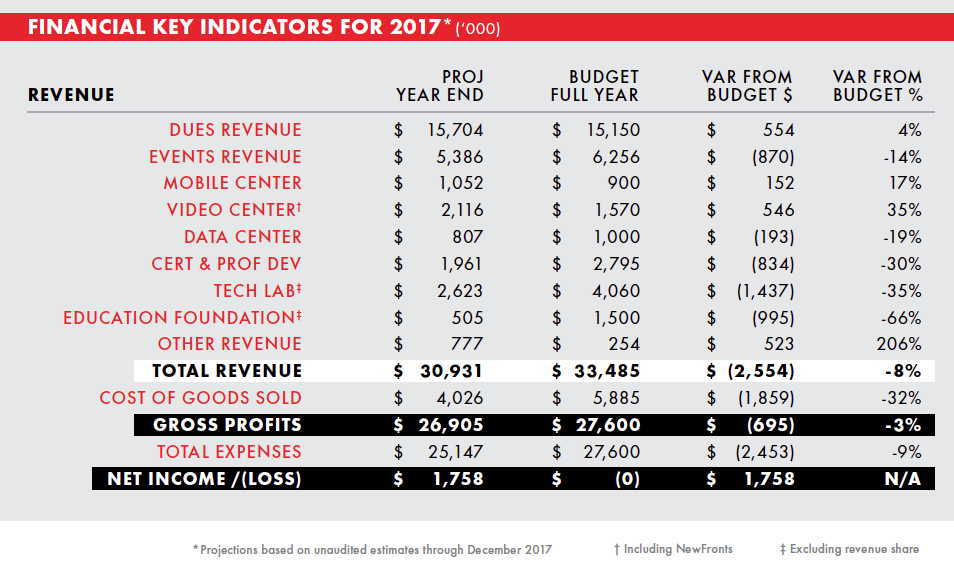
As the digital media and advertising industry has grown, our members have asked for more training programs to grow the talent pool. The IAB Certification Programs and Professional Development, established five years ago, totaled $2 million in revenue, similar to last year. The continued health of the certification programs is a validation from our members of how important certifications and training are for career growth and to build a healthy talent pipeline for our industry.
IAB organizations are also taking hold and delivering on revenue. The IAB Tech Lab brought in $2.6 million in its third year of operation (up from $2 million last year) to develop tools, standards, and best practices that simplify and reduce costs associated with the digital advertising and marketing supply chain. IAB also received $505,000 in donations to the IAB Education Foundation and its iDiverse initiative in 2017 for building a more diverse talent pipeline.
The Centers of Excellence are also showing ongoing progress. The IAB Mobile Marketing Center of Excellence is projected to see $1 million in revenue in 2017, which is $203,000 more than expected and a positive sign for the relevance and success of our Mobile Always efforts. The Video Center of Excellence saw revenue of $2.1 million (up sharply from $1.3 million in 2016), including the wildly popular Digital Content NewFronts industry event. The Data Center of Excellence saw revenue jump to $807,000, up from $550,000 in 2016.
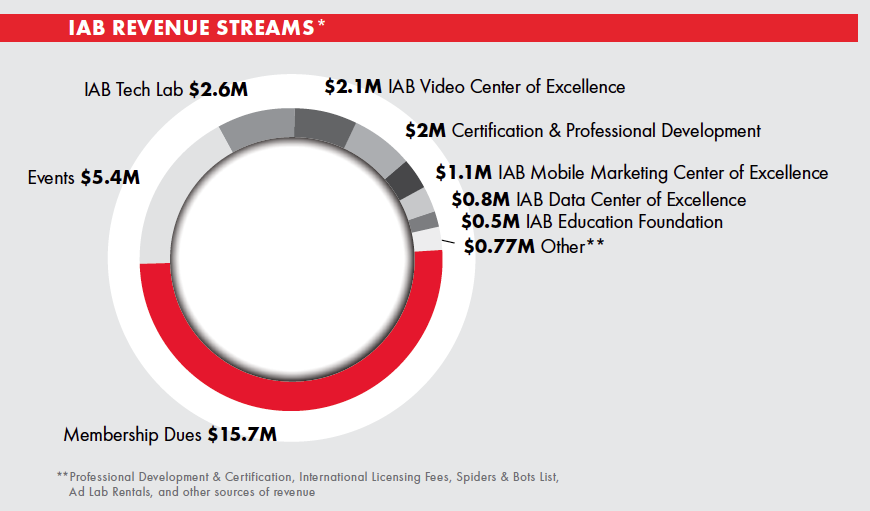
Additional ongoing revenue streams include initiatives such as sponsored research, member services, international licensing fees, and other fundraising programs.
In 2017, IAB invested revenues received towards helping member businesses grow and excel. Funding was directed toward producing valuable third-party research for building brands in digital media as well as investing in the IAB Video Center of Excellence, the relatively new IAB Data Center of Excellence, and the IAB Education Foundation. We also made additional investments in the IAB Tech Lab to lead the industry toward a more transparent and secure supply chain, which we believe is a foundation for the future growth of our members.
Overall, IAB managed expenses closely in 2017, which totaled $25.1 million, and closed the year with a surplus of $1.7 million.
With our members’ support, IAB is well positioned financially to deliver on an ambitious agenda for championing industry growth in 2018 and beyond.
Who We Are
EXECUTIVE COMMITTEE 2017
Randall Rothenberg
IAB
BOARD CHAIR
Scott Schiller
NBC Universal
SECRETARY
Stu Ingis
Venable LLPAllie Kline
Oath
The New York Times CompanyDavid Morris
CBS Interactive
Sridhar Ramaswamy
Google
Vivek Shah
Ziff Davis, LLC
TREASURER
John Toohey
Charter Communications
Microsoft AdvertisingLauren Wiener
Tremor Video
Troy Young
Hearst Magazines Digital Media
EX-OFFICIO MEMBER OF EXECUTIVE COMMITTEE
David Moore
Xaxis
BOARD OF DIRECTORS 2017
VistoLee Brown
Buzzfeed
Seth Dallaire
Amazon Media Group
Rick Erwin
Acxiom
Rita Ferro
Disney | ABC Television Group
Rajeev Goel
Pubmatic
Keith Grossman
Bloomberg
Chris Guenther
NewsCorp
Jed Hartman
The Washington Post
Mark Howard
Forbes Media
Allie Kline
Oath
The New York Times CompanySeth Ladetsky
Turner Broadcasting System
Jeff Lucas
Snapchat
Jean-Philippe Maheu
Twitter
Peter Naylor
Hulu
Kimberly Norris
Spectrum (Time Warner Cable)
Marian Pittman
Cox Media Group
Penry Price
LinkedIn
Sridhar Ramaswamy
Google
Michael Rubenstein
AppNexus
Carrie Siefer
IBM
SheKnows MediaBrad Smallwood
John Trimble
Pandora
Lisa Valentino
Condé Nast Entertainment
Jacob Weisberg
Slate
Rick Welday
AT&T AdWorks
Steven Wolfe Pereira
Quantcast
Jen Wong
Time Inc. Digital
Troy Young
Hearst Magazines Digital Media
Joe Zawadzki
MediaMath
FORMER 2017 BOARD MEMBERS
News CorporationPaul Caine
Bloomberg Media
Frank Cooper
BuzzFeed
SheKnowsMichael Friedenberg
IDG Communications
Joan Gillman
TWC Media
ESPNHarold Morgenstern
Discovery Communications
Neal Mohan
YouTube
EX OFFICIO
Venable LLPRich LeFurgy
Archer Advisors
XaxisJohn Toohey
Charter Communications

